Performance+ OKU Panel Solar Pool Heating System -- Installation and User Manual
These online install instructions are also available in printable pdf form; download here - Performance+ OKU Panel Solar Pool Heating System -- Installation and User Manual.
Tip: If you need to email us a question about a specific section of this manual, you can use the headings "Get Link" button to copy a hyperlink which will automatically jump to that section when loaded on a browser.

EcoOnline Performance+™ Solar Pool Heating System -- Installation & User Manual
© Copyright 2021 Optex Solar Pty Ltd. All rights strictly reserved.
EcoOnline™ Performance+
OKU Panel Solar Pool Heating System
Installation and User Manual - Revised 19/11/2021
Optex Solar Pty. Ltd.
ABN: 88 128 228 884
www.EcoOnline.com.au
email: info@EcoOnline.com.au
© Copyright 2021 Optex Solar Pty Ltd. All rights strictly reserved. This publication is protected by copyright law
and unless otherwise specified is for your personal and non-commercial use only. No part of this publication
may be reproduced or distributed by any process, electronic or otherwise, without the specific written
permission of Optex Solar Pty Ltd. Trademarks appearing in this manual are the sole property of Optex Solar
Pty Ltd or their respective owners. Nothing in this publication shall be construed as granting any express or
implied license to use any intellectual property of Optex Solar Pty Ltd otherwise than for personal and
non-commercial use only. Optex Solar Pty Ltd must not, to the full extent permitted by law, be held liable
for any claim, cost (including legal costs), damage, expense, loss (including fines, penalties, set-offs and
consequential loss) or liability arising from the use (or misuse) of any product described in this
publication, unless expressly provided otherwise in this publication. Information as well as any
products described in this publication are subject to change without notice.

EcoOnline Performance+™ Solar Pool Heating System -- Installation & User Manual
© Copyright 2021 Optex Solar Pty Ltd. All rights strictly reserved.
Page 2
Contents Click Heading Titles to Navigate Up or Down
14.1 Ladder Safety

EcoOnline Performance+™ Solar Pool Heating System -- Installation & User Manual
© Copyright 2021 Optex Solar Pty Ltd. All rights strictly reserved.
Page 3

EcoOnline Performance+™ Solar Pool Heating System -- Installation & User Manual
© Copyright 2021 Optex Solar Pty Ltd. All rights strictly reserved.
Page 4
26.1 Drain Down
26.2 Winterization
30.1 Notes on First Usage
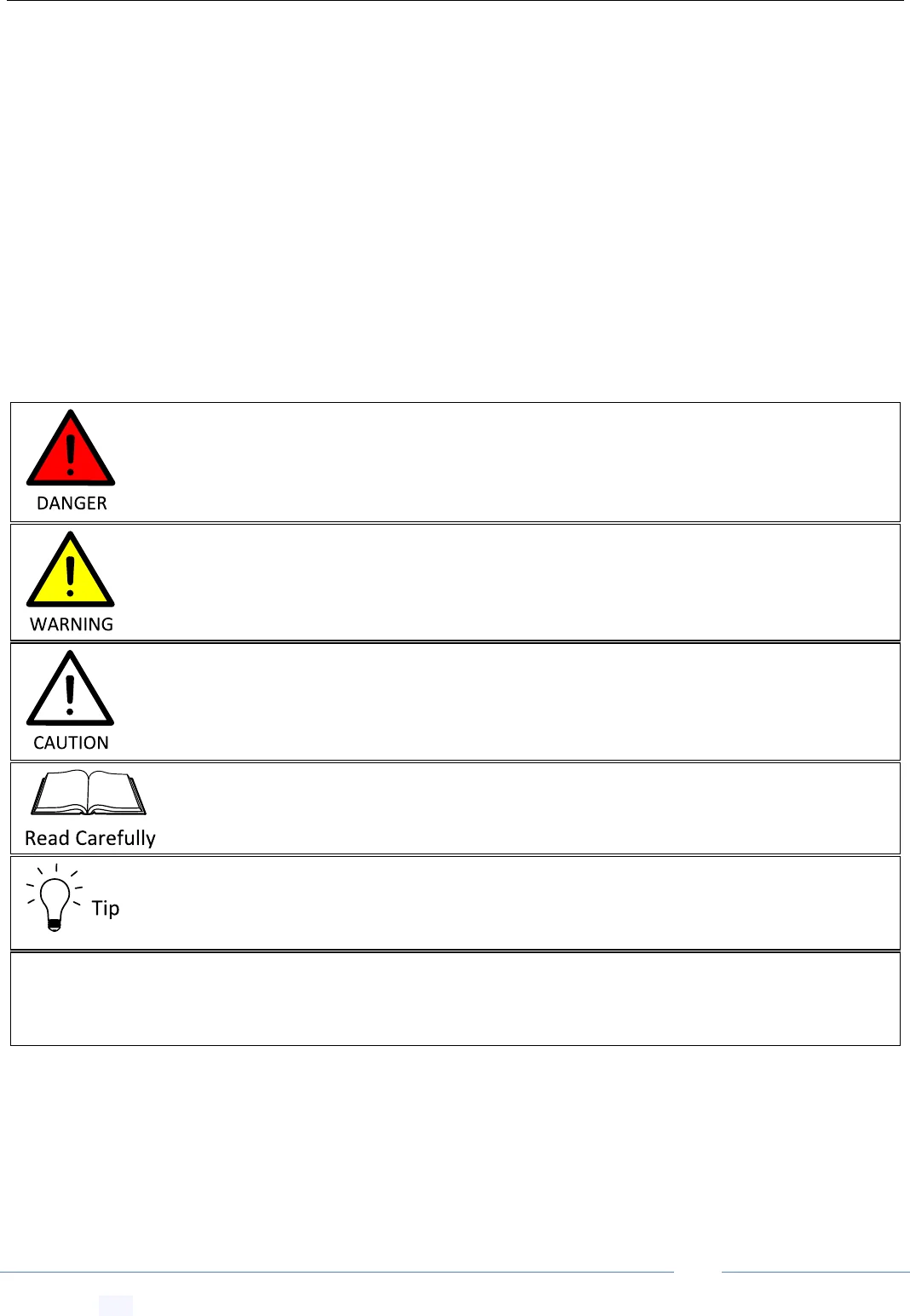
EcoOnline Performance+™ Solar Pool Heating System -- Installation & User Manual
© Copyright 2021 Optex Solar Pty Ltd. All rights strictly reserved.
Page 5
1 Key Terms
Create jump link to this section-- Get Link
This manual was written to follow guidelines and recommendations given in:
AS 3634 - 1989 Solar heating systems for swimming pools
AS 1170.2 - 2011 (Amend 2 Dec 2012) Structural design actions - Wind actions
‘HAZPAK’ produced by the work-cover authority
AS 3000 (2007) Sections 6.3, 6.4 & 6.5
AS 1926.1 & 1926.2 (2007) swimming pool safety - location of safety barrier
Please take the time to read this manual before starting any work. Particular attention should be given to text
contained in the following key terms.
Please note EcoOnline has a strong product safety policy; do not install products without reading safety guidelines in
the manual. Please report any product safety issues or near misses to info@EcoOnline.com.au no matter how trivial.
Refers to useful information for the optimal operation of the system
Indicates a SAFETY issue that is likely to cause injury or death if the user does not
follow the instructions.
Indicates a SAFETY issue that may cause injury or death if the user does not follow the
instructions.
Indicates a SAFETY issue that may cause injury or property damage if the user does
not follow the instructions
Refers to critically important information related to the correct functioning of the
system.
Why? Italic text is optional reading. Gives extra information and reasoning for recommendations that are
non-obvious and/or counter intuitive.
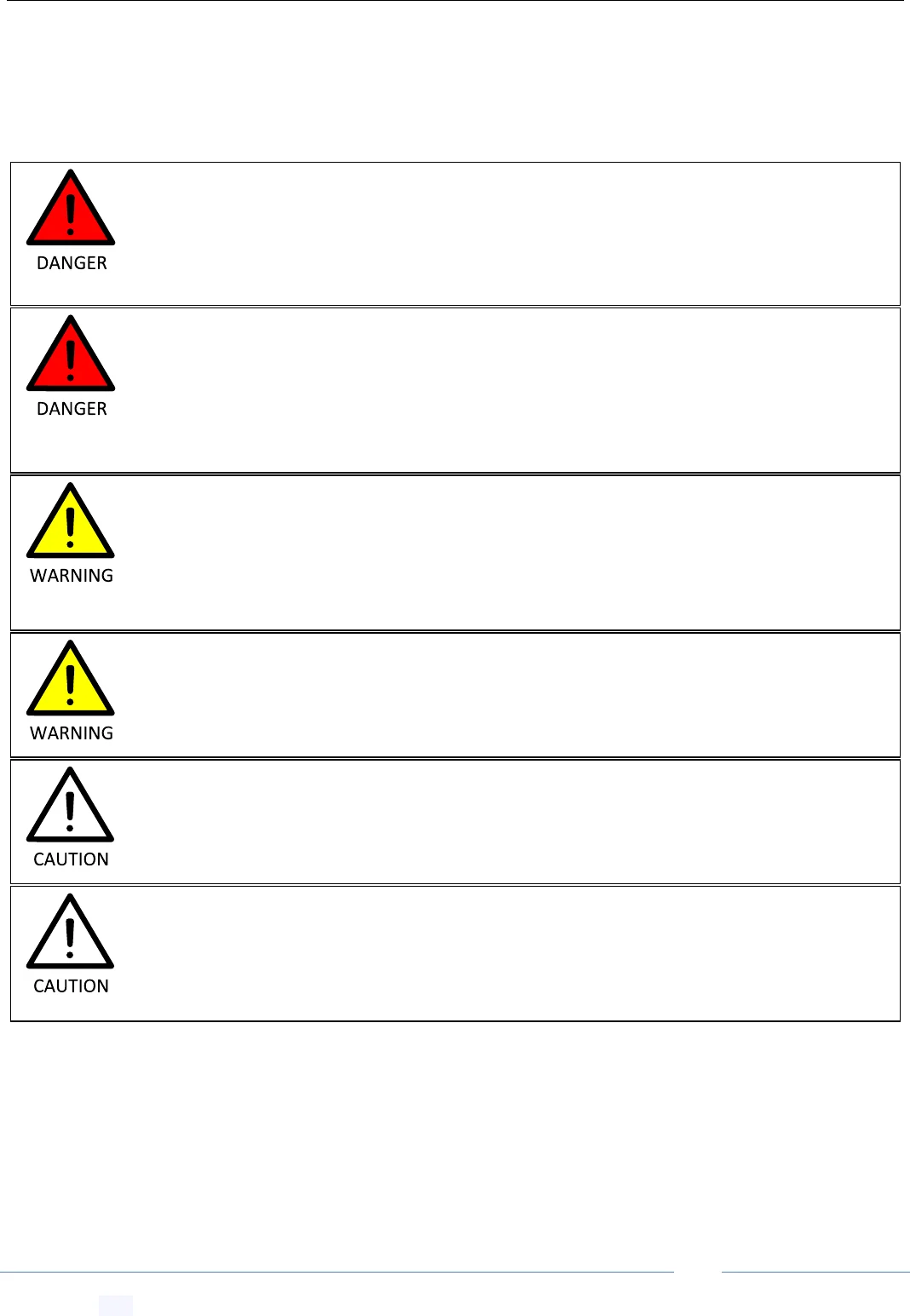
EcoOnline Performance+™ Solar Pool Heating System -- Installation & User Manual
© Copyright 2021 Optex Solar Pty Ltd. All rights strictly reserved.
Page 6
2 Pre-Installation Suitability and Safety Checklist
Create jump link to this section-- Get Link
The following outlines mandatory suitability and safety requirements for installing this solar heating system. Please
read carefully, if any of the following requirements cannot be meet the system should NOT be purchased or
installed.
For ground level collector installations the installer MUST check child safety fence regulations
in the relevant state. Under no circumstances should collectors be installed so as to
compromise the effectiveness of a child pool or spa fence safety barrier by providing a
climbable object.
Building regulations vary from state to state and MUST override any instructions supplied in
this manual. It is the responsibility of the purchaser/installer to check that installations
comply with any relevant state laws and regulations.
At present this collector array system is not recommended for exposed installations in
cyclonic regions C or D, or on houses situated on top of hills in cyclonic region B, or on
second story (or higher) roofs. Installations on tiles are for Wind Region A only.
Collectors are to be used with chlorinated (or otherwise sanitized) pool water ONLY. Do not
use collectors to heat fresh (untreated) water due to the potential for Legionaries bacteria
build up.
This appliance is not intended for use by persons (including children) with reduced physical,
sensory or mental capabilities, or lack of experience and knowledge, unless they have been
given supervision or instruction concerning use of the appliance by a person responsible for
their safety. Children should be supervised to ensure that they do not play with the appliance.
Due to the potential of falling from heights, mounting panels on a roof or structure at
heights should only be undertaken by a professional installer, unless you are accustomed
to and confident of performing the work safely. We strongly recommend the installer
invests in roof safety guard rails and a safety harness system, especially for DIY
applications.
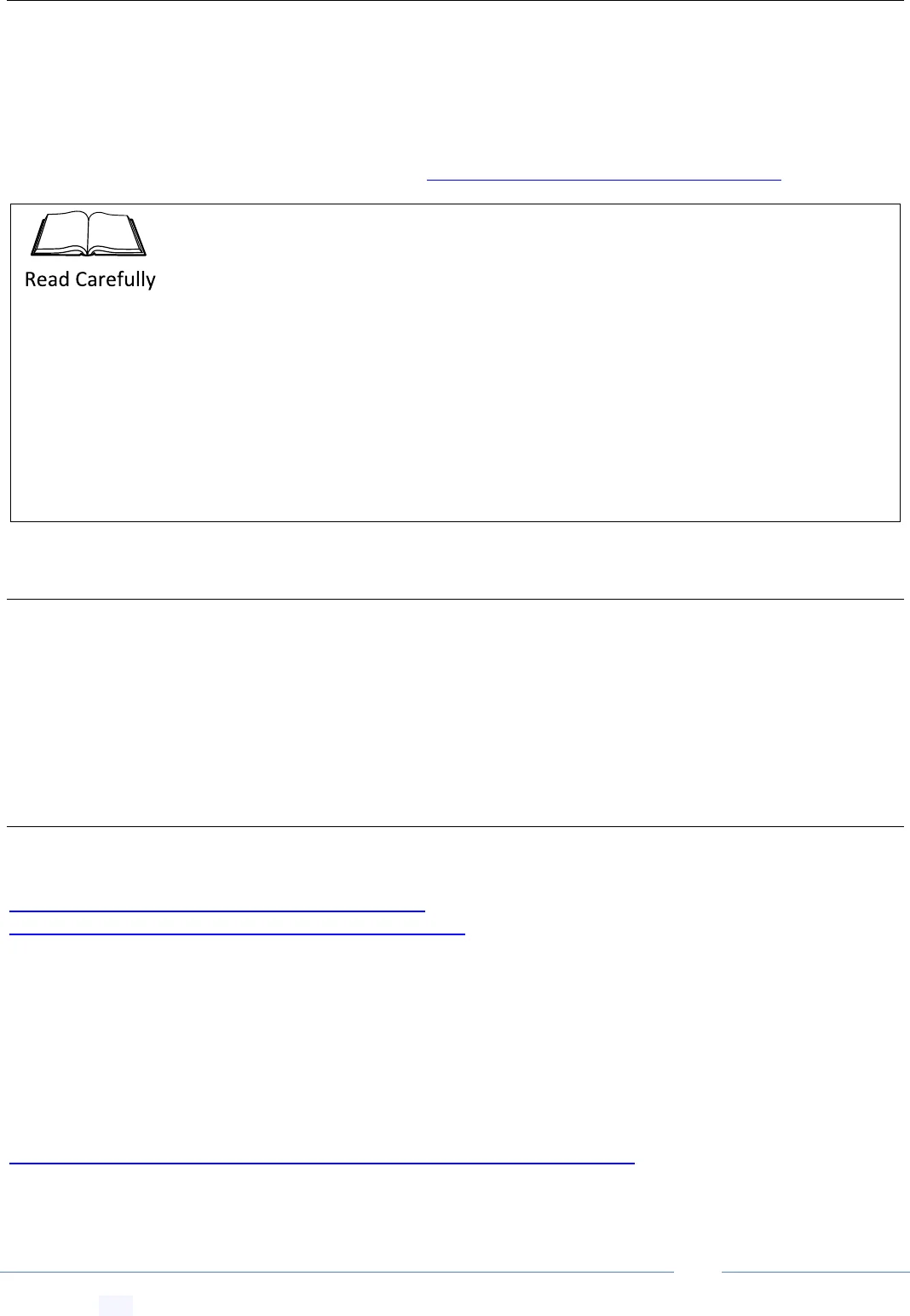
EcoOnline Performance+™ Solar Pool Heating System -- Installation & User Manual
© Copyright 2021 Optex Solar Pty Ltd. All rights strictly reserved.
Page 7
3 Warranties
Create jump link to this section-- Get Link
EcoOnline™ offers the following Warranties
35 year limited Warranty on all OKU collectors
2 year Warranty on Davey Pool Pumps
3 Year Warranty on Dontek and Ascon Controllers
See our Terms and Conditions page for further details: www.EcoOnline.com.au/terms-and-conditions
4 System Sizing Guarantee
Create jump link to this section-- Get Link
Sizing systems is difficult involving a lot of factors which we could get wrong. Hence in addition to the above
Warranties EcoOnline offers a System Sizing Guarantee as follows. If we sized your system (or you use our online
calculator) and you took our advice and you aren’t happy with the system’s performance (heat output), then you can
purchase up to 25% more panels originally supplied by EcoOnline up to two years after your original purchase and
we will ship the items free of shipping charges.
5 Collector Sizing Guide
Create jump link to this section-- Get Link
An interactive collector sizing calculator and pool water temperature simulator can be found on our website at:
www.EcoOnline.com.au/pool-heating-sizing-calculator
www.EcoOnline.com.au/pool-water-temperature-simulator
5.1 A Word on Transparent Bubble Pool Covers
Create jump link to this section-- Get Link
EcoOnline recently carried out a full pool heating loading technical study including performance data on transparent
bubble pool covers. We found that while transparent pool covers produce a moderate heating effect by themselves,
they produced a much larger pool temperature boost when used in conjunction with a solar pool heater due to
synergistic effects. So much so that if you’re running a solar pool heater and not using a pool cover you are missing
out on surprisingly large temperature gains - see link below for the summaries:
www.EcoOnline.com.au/how-warm-can-a-pool-get-with-a-solar-heater-and-cover
Customer please note: WARRANTY IS VOID if collectors are installed:
without a vacuum release valve on the return line,
or a non-return valve on the solar pump outlet (with 6mm drain hole in flap),
or if panels are run at pressures other than a maximum of ± 1psi (6kPa),
or if the collectors are installed well below the water level (max 1.5m).
Why? Such installations will expose the collectors to strong fatiguing positive/negative
pressures. These situations will have detrimental effects on the collectors which will limit
lifetimes and can also result in significant shrinkage of the collectors which would put
strain on roof attachments.
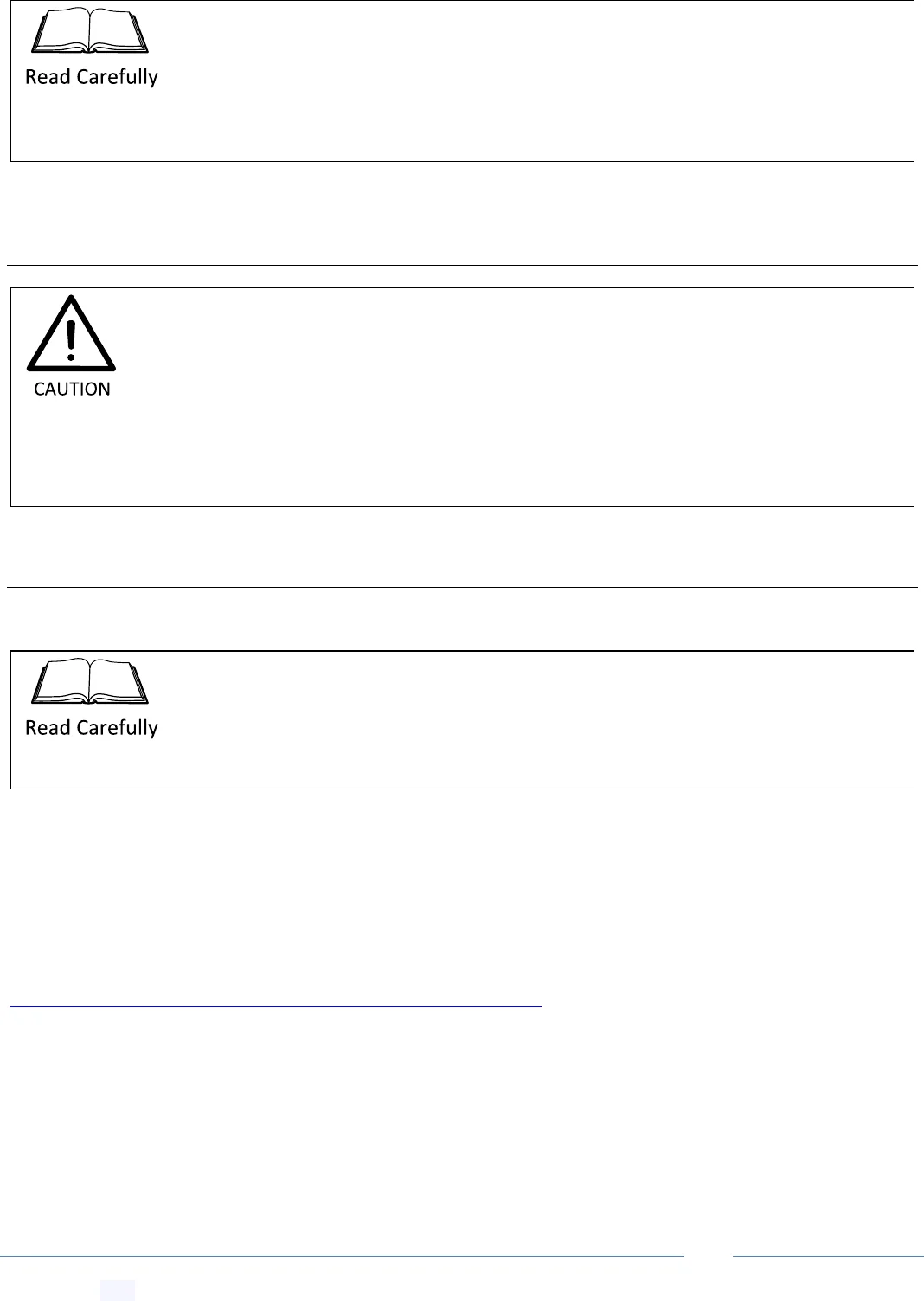
EcoOnline Performance+™ Solar Pool Heating System -- Installation & User Manual
© Copyright 2021 Optex Solar Pty Ltd. All rights strictly reserved.
Page 8
So if you’ve used a pool cover before and had disappointing results, we highly recommend you try using a cover
again after you install our solar pool heating system.
6 Pool Chemistry Compatibility Guide
Create jump link to this section-- Get Link
7 Pump Sizing Guide
Create jump link to this section-- Get Link
7.1 A Word on Pump Sizing Choice
Create jump link to this section-- Get Link
The quick reference tables below outline Australian Standard pump sizing recommendations.
There is a range of pump powers one can choose from. If thermal system efficiency is important then choose a pump
at the high end to produce a high flow rate; take care not to over-pressurize your system (see Optimizing Collector
Pressure below). If electrical efficiency (COP factor) is important to you then choose a pump near the lowest power
range. To help you understand the potential savings from such choices we have created an interactive pump sizing
simulator which can be found on our website at:
www.EcoOnline.com.au/oku-performance-pool-heating-pump-sizing
However, if you go with a lower power pump you’ll need the following:
A slightly larger collector area; the pump sizing calculator will let you know by how much.
You will need to check with the pump manufacture that your chosen pump can still prime reliably at your
pump height.
We highly recommend you use a by-pass line to help your pump prime reliably, see Installing a By-Pass Tube
or By-Pass Ball Valve section below.
Please note the silicon joiners used in the system are not compatible with acidic pool/spa
water (pH less than 7.2). Sodium Carbonate must be added to protect the system from acidic
pH (<7). pH should be maintained between 7.2-7.8 for maximum longevity. If required Sodium
Bisulphate acid can be used to keep the pH down.
Why? Acidic water with pH less than 7.0 has excess free H+ ions which like to bond to and
hence break apart silicon bonds.
Only highly transparent clear and light blue solar blankets increase water
temperatures; silver backed or non-transparent solar blankets reject sunlight and will
substantially cool your pool - this is irrespective of whether or not the silver side faces
up or down. Non-transparent blankets are okay to use for 100% shaded pools only.
Variable speed or PV solar powered pool pumps are not to be used with OKU panels.
Why? Such pumps have large start up currents and will expose panels to high fatigue
working pressure fluctuations.

EcoOnline Performance+™ Solar Pool Heating System -- Installation & User Manual
© Copyright 2021 Optex Solar Pty Ltd. All rights strictly reserved.
Page 9
Lastly you may need to run your main filter pump in the afternoon to help mix the warm water if your pool
volume turnover falls below the 50% - 75% range.
Australian Standard Input Pump Power for Independent Systems
For 1
st
Story Install (3m):
For 2
nd
Story Install (6m):
Pool
Water
Volume
Min - Max
Recommended
Flow
Min - Max
Input Pump Watts
Min - Max
Input Pump Watts
20,000 L
50 - 67 L/min
270 - 300 Watts
350 - 380 Watts
25,000 L
63 - 83 L/min
300 - 330 Watts
370 - 410 Watts
30,000 L
75 - 100 L/min
320 - 370 Watts
400 - 450 Watts
35,000 L
88 - 117 L/min
340 - 400 Watts
420 - 480 Watts
40,000 L
100 - 133 L/min
360 - 440 Watts
450 - 520 Watts
45,000 L
113 - 150 L/min
390 - 470 Watts
470 - 560 Watts
50,000 L
125 - 167 L/min
420 - 510 Watts
500 - 600 Watts
55,000 L
138 - 183 L/min
450 - 560 Watts
530 - 640 Watts
60,000 L
150 - 200 L/min
470 - 600 Watts
560 - 690 Watts
65,000 L
163 - 217 L/min
500 - 640 Watts
600 - 740 Watts
70,000 L
175 - 233 L/min
530 - 700 Watts
620 - 790 Watts
75,000 L
188 - 250 L/min
570 - 740 Watts
660 - 840 Watts
80,000 L
200 - 267 L/min
600 - 790 Watts
700 - 900 Watts
If you don’t know your pools water volume you can look it up from the table supplied below based on the total
water area and average depth:
Pool Water area vs Average Depth Conversion Table
Average depth
Waters Area
1.3 m
1.4 m
1.45 m
1.5 m
1.55 m
1.6 m
1.65 m
1.7 m
1.8 m
10 m
2
13000 L
14000 L
14500 L
15000 L
15500 L
16000 L
16500 L
17000 L
18000 L
15 m
2
19500 L
21000 L
21750 L
22500 L
23250 L
24000 L
24750 L
25500 L
27000 L
20 m
2
26000 L
28000 L
29000 L
30000 L
31000 L
32000 L
33000 L
34000 L
36000 L
25 m
2
32500 L
35000 L
36250 L
37500 L
38750 L
40000 L
41250 L
42500 L
45000L
30 m
2
39000 L
42000 L
43500 L
45000 L
46500 L
48000 L
49500 L
51000 L
54000 L
35 m
2
45500 L
49000 L
50750 L
52500 L
54250 L
56000 L
57750 L
59500 L
63000 L
40 m
2
52000 L
56000 L
58000 L
60000 L
62000 L
64000 L
66000 L
68000 L
72000 L
45 m
2
58500 L
63000 L
65250 L
67500 L
69750 L
72000 L
74250 L
76500 L
81000 L
50 m
2
65000 L
70000 L
72500 L
75000 L
77500 L
80000 L
82500 L
85000 L
90000 L
55 m
2
71500 L
77000 L
79750 L
82500 L
85250 L
88000 L
90750 L
93500 L
99000 L

EcoOnline Performance+™ Solar Pool Heating System -- Installation & User Manual
© Copyright 2021 Optex Solar Pty Ltd. All rights strictly reserved.
Page 10
7.2 Solar Pump Sizing for Booster Systems
Create jump link to this section-- Get Link
7.3 Filter Pump Sizing for Manual Systems
Create jump link to this section-- Get Link
8 Solar Line PVC Pipe Sizing Guide
Create jump link to this section-- Get Link
The table below will help you choose the correct size PVC pipe for the solar lines running to and from your roof. On
the roof, we generally recommend 32 PVC (DN30), except for larger multiple row arrays with a secondary header
pipe feeding each row, for which you should use 40 PVC (DN40). Coming down the roof the pipe size can then be
adapted to the pipe size you have for your solar line ground run i.e. 40 PVC (DN40) or 50 PVC (DN50).
Recommended PVC Piping Sizing for Solar Pool Heating System Lines
Anticipated Flow Rate
Absolute Minimum
Ideal PVC Pipe Size
Maximum Pipe Size
70 Litres/min
20 PVC (DN20)
25 PVC (DN25)
32 PVC (DN30)
120 Litres/min
25 PVC (DN25)
32 PVC (DN30)
40 PVC (DN40)
200 Litres/min
32 PVC (DN30)
40 PVC (DN40)
50 PVC (DN50)
250 Litres/min
40 PVC (DN40)
50 PVC (DN50)
65 PVC (DN65)
400 Litres/min
50 PVC (DN50)
65 PVC (DN65)
80 PVC (DN80)
880 Litres/min
80 PVC (DN80)
100 PVC (DN100)
125 PVC (DN125)
For booster type systems you should choose a pump at or just below the minimum
specs in the table above. Why? The take off point for solar is already pressurized by the
filter pump, hence a smaller pump should be used.
For manual type systems running off the main pool filter pump, please check that the
filter pump is large enough to accommodate the extra load of supplying water to the
collectors at the required pump height + a 1 meter pressure drop across the collector
array. Why? Filter pumps are geared for flow not pump height, solar pumps are geared
specifically for roof solar applications.
If the distance from the pool to the roof collector area is more than 10m we recommend
you use the next size up PVC pipe.
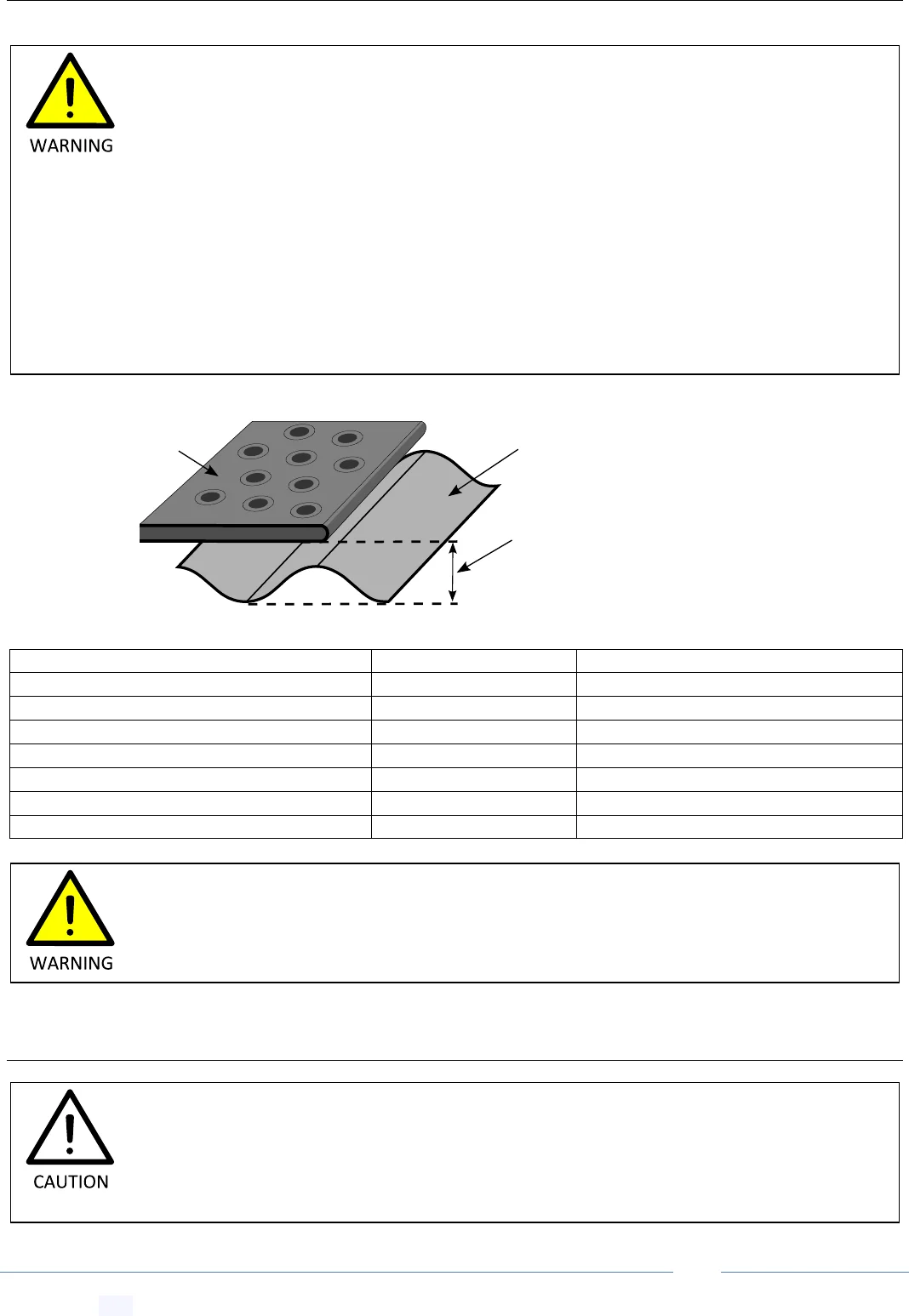
EcoOnline Performance+™ Solar Pool Heating System -- Installation & User Manual
© Copyright 2021 Optex Solar Pty Ltd. All rights strictly reserved.
Page 11
9 Roof Type Compatibility Guide
Create jump link to this section-- Get Link
Roof Type
Peak to Valley Measure
Recommendations
Standard Corrugated Iron roof (Custom Orb)
17mm
Use Respective Wind Region Fixings
Relatively Flat Tile roof
Less than 25mm
Use Respective Wind Region Fixings
Spandek Iron roof
24mm
Use Respective Wind Region Fixings
Modulated Tile roof
Greater than 25mm
Use Next Level Wind Region Fixings
Trimdek Iron roof
29mm
Use Next Level Wind Region Fixings
Klip-lok Iron roof
43mm
Use Highest Wind Region C Fixings
Flatdek Iron roof
45mm
Use Highest Wind Region C Fixings
10 Wind and Climate Considerations
Create jump link to this section-- Get Link
Collector bottom to roof valley air
gap should perferably be less than ~ 45mm
(for gaps > 45mm - use Wind Region C fixings)
Corregated metal roof
or tile roof
Collector Panel
If panels are to be installed on a roof then the following should be observed to limit wind
uplift potential.
1) Installed panels should lay flat close to the roofs surface. It is recommend the air
gap distance between the bottom of the installed collector and the valley points of
the roof corrugations should be no greater than approximately 40mm.
2) Panels should have adequate clearance from roof edges.
3) Panels on roofs MUST NOT be mounted on tilt frames.
Why? The average air gap distance between the mounted collector and roof structure has a
strong influence on wind loadings. Furthermore due to roof edge turbulence effects wind
loadings are highest near roof edges.
Panels installed above the roof structure with 50mm or greater underneath air gaps experience
much higher wind loadings and are now subject to the Australian wind loading standard
AS/NZD 1170.2.
It is the responsibility of the installer to consider wind loading factors, see “wind proofing”
section below. If the installation site is within strong wind speed areas then the extra
stainless steel guide line must be installed across each row with the in-between panel
anchor points. Do not assume supplied components are sufficient.
sufficient.
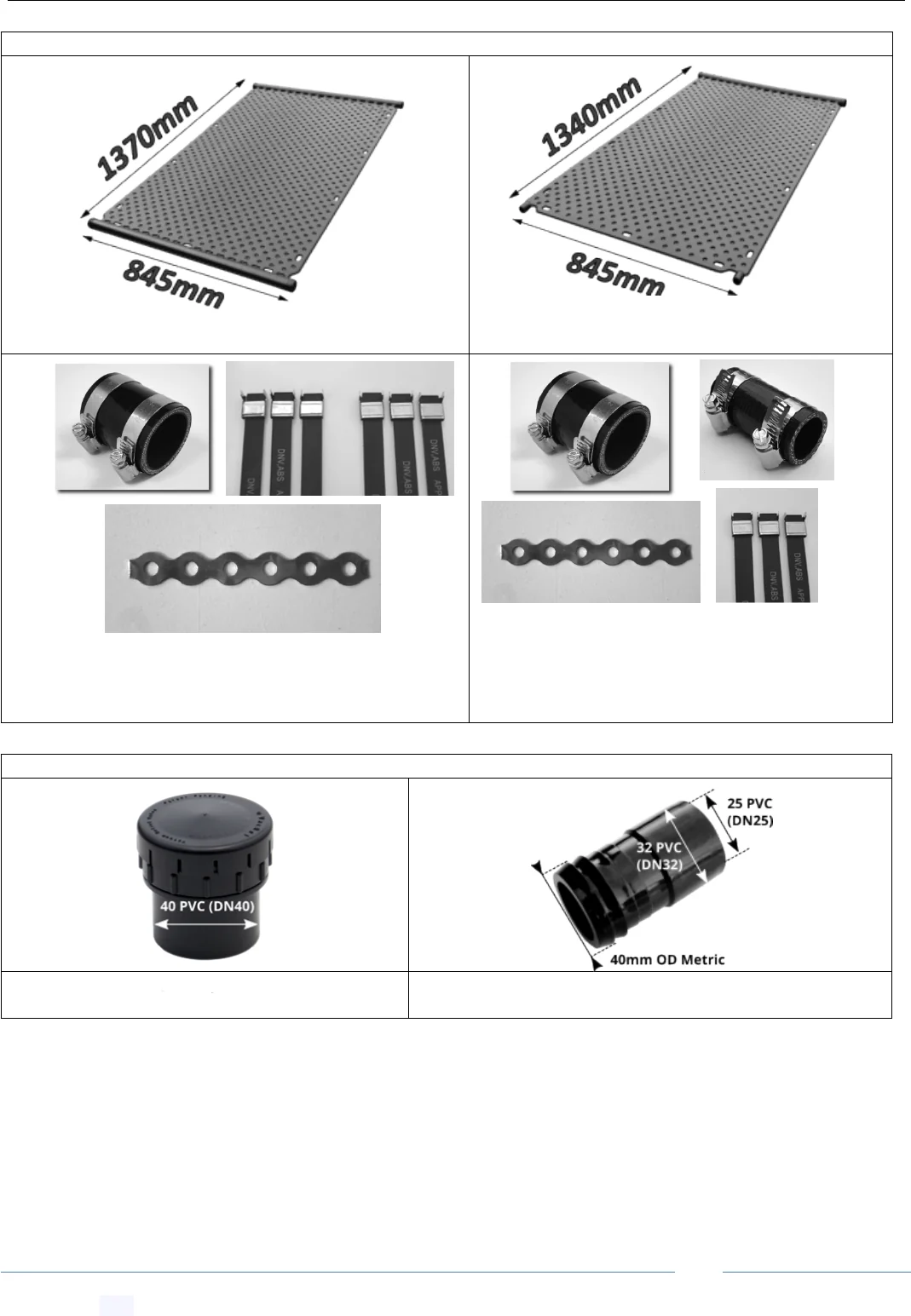
EcoOnline Performance+™ Solar Pool Heating System -- Installation & User Manual
© Copyright 2021 Optex Solar Pty Ltd. All rights strictly reserved.
Page 12
11 Collector Array Components
Create jump link to this section-- Get Link
Interconnect OR Dual Header Panel Kit:
1 × HDPE dual header panel
1 × HDPE interconnect panel
2 × 40mm ID reinforced silicon joiners
4 × Stainless steel hose clamps
6 × 316 Stainless steel straps (black)
1 × 10cm length perforated 316 stainless band
1 × 40mm ID reinforced silicon joiner
1 × 25mm ID reinforced silicon joiner
4 × Stainless steel hose clamps
3 × 316 Stainless steel straps (black)
1 × 10cm length perforated 316 stainless band
Other Collector Array Components
1 × 40 PVC Vacuum breaker valve
(MUST be installed)
2 × 40mm OD hose barb to 25/32 PVC glue socket/take off
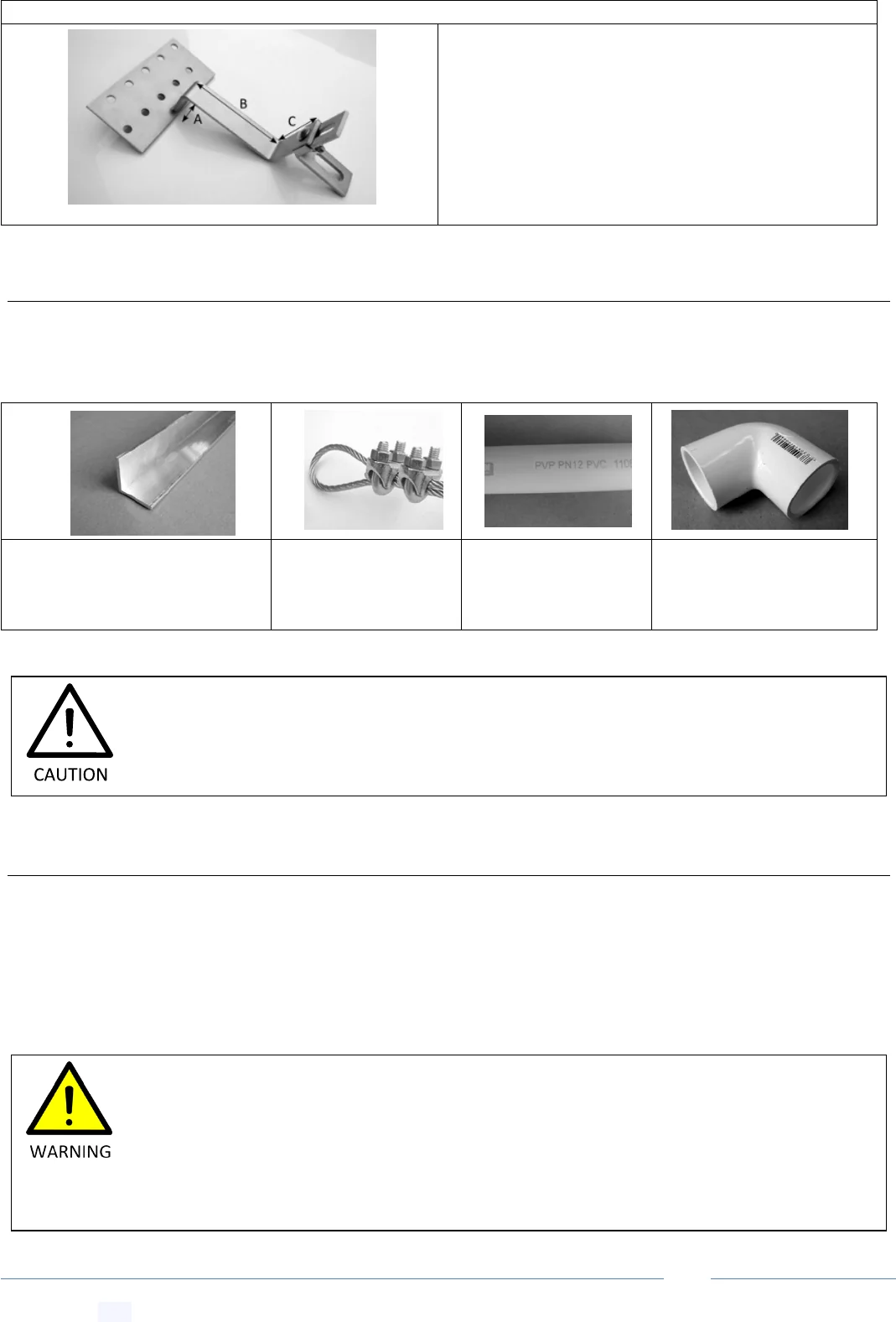
EcoOnline Performance+™ Solar Pool Heating System -- Installation & User Manual
© Copyright 2021 Optex Solar Pty Ltd. All rights strictly reserved.
Page 13
12 Additional Required Components (Not Supplied)
Create jump link to this section-- Get Link
You also require some of the following extra items depending on your system. These are available in any plumbing
store. The aluminium angle is available from Capral Ltd. or Ullrich Aluminium Pty. Ltd.
13 Required Tools
Create jump link to this section-- Get Link
- Battery powered hand drill
- Screwdriver
- Safety glasses
- Corking gun (for Silicon glue)
- Hack saw
- Gloves
- Personal Sun/UV protection
- Assorted drill bits
- Power Lead
- Heat Gun
- Tape measure
- Tin snips
- Industrial Ladder
- Needle nose pliers
- Power Lead
- A single 32 PVC (or 20 PVC) Socket – for heat smoothing any misshapen barbs (see below)
Roof Mounting (Solar roof hook supplied only if requested and purchased)
1 × 304 Stainless solar roof hook (height adjustable)
Dimensions: A = 47.5mm,B = 112mm,C = 60mm
Aluminium angle 30mm x 30mm
x 4mm for metal roofs. 40mm x
40mm x 3mm for tile roofs
4mm stainless steel
cable & four cable ties
per row
PVC piping
(recommend 32 PVC
(DN30) on roof)
PVC bits, including a 32
PVC (DN30) or 20 PVC (DN
20) socket for heat
smoothing barbs
We recommend AS 1477 compliant PVC piping with PN9 pressure rating or greater and
matching PVC fittings be used for all collector array plumbing.
When working with power or hand tools always follow the safety instructions. Wear the
recommended personal protective equipment, such as gloves, safety glasses, respiratory and
hearing projection. Make sure electrical cables are kept away from any water and from
foreign objects which pose a potential cable severing or crushing hazard. When using glues,
solvents or sealing agents make sure you know and seek the proper first aid in case of an
accident.
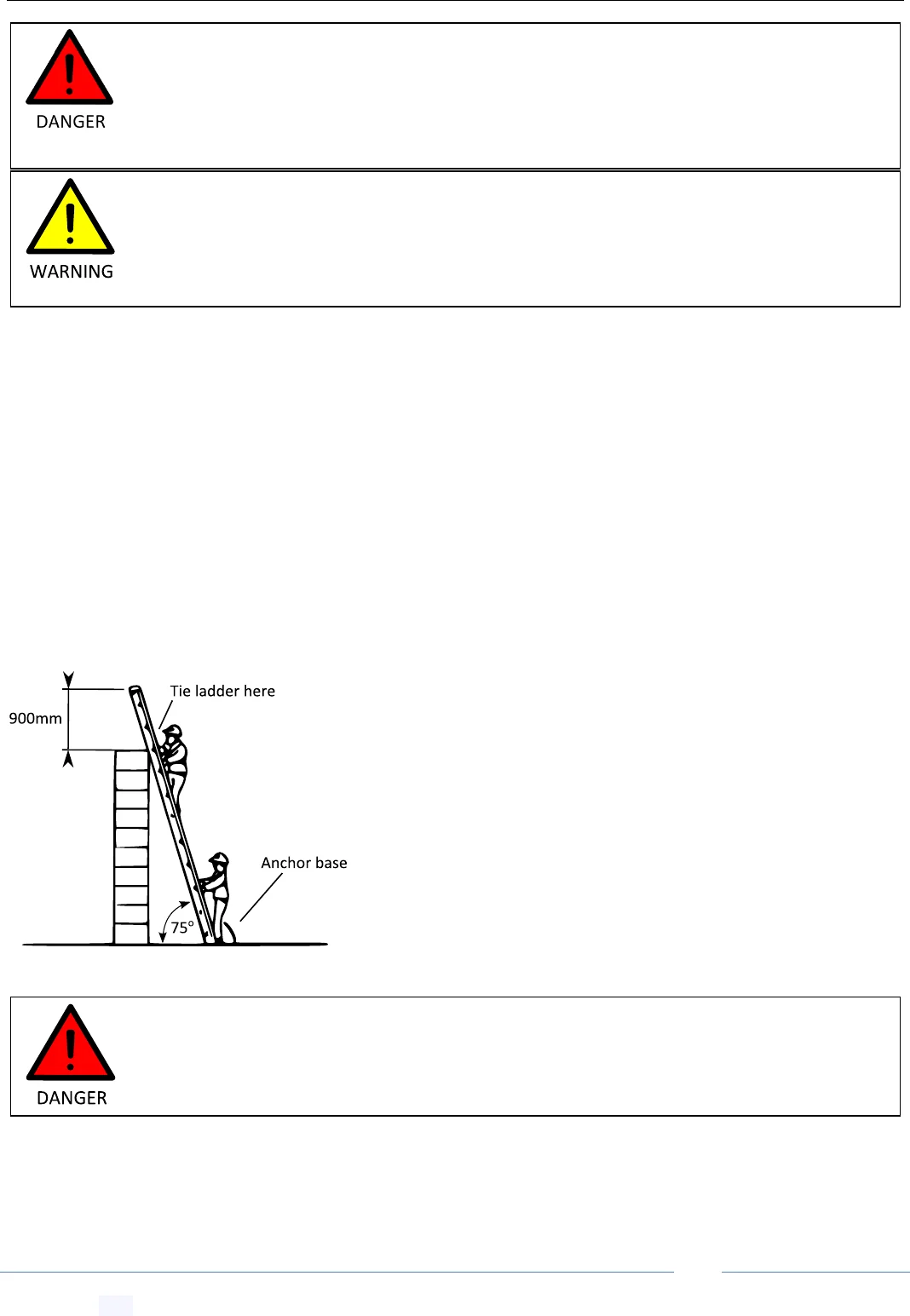
EcoOnline Performance+™ Solar Pool Heating System -- Installation & User Manual
© Copyright 2021 Optex Solar Pty Ltd. All rights strictly reserved.
Page 14
14 Safety When Working at Heights
Create jump link to this section-- Get Link
The installer should always take the necessary safety precautions:
Choose an appropriate day: cool, dry, calm and partly cloudy.
Plan out your install: make sure you have all required components, tools and have plenty of allocated time.
Only work at heights when you are well rested and alert.
Never work alone, always work with at least one other person.
Always use a safety harness or fall arrest system attached to appropriate roof anchor points.
Wear clothes that fit well but that do not restrict movement.
Use proper non-slip shoes.
Use sunscreen.
14.1 Ladder Safety
Create jump link to this section-- Get Link
The chance of a falling from a ladder should never be
underestimated. Use only solid industrial grade ladders in good repair
that have been checked for faults.
Note: even a small unexpected movement of the ladder, such as a
small slip, can cause loss of balance and result in a fall.
The ladder should be placed on solid ground and should ALWAYS be
securely anchored at the base and secured at the top to prevent
slipping.
WHEN WORKING AT HEIGHTS - SAFETY COMES FIRST. A person can easily fall off a ladder or
roof and be seriously injured. For installations on a roof pitch greater than 22° and/or a double
story house we strongly recommend a highly competent professional installer install your solar
collector array. We strongly recommend the installer invests in roof safety guard rails and a
safety harness system, especially for DIY applications.
Solar panels should not be mounted in windy or gusty conditions; a panel can easily be caught
in the wind and cause a loss of balance and result in a fall.
The collectors can be walked on without damage. Take extreme care to use non-slip shoes and
never walk on wet collectors, especially on installations with any significant pitch. HDPE
material is a slippery and waxy surface. If the collectors need to be walked on for mounting
purposes, ALWAYS use a safety harness and fall arrest system.

EcoOnline Performance+™ Solar Pool Heating System -- Installation & User Manual
© Copyright 2021 Optex Solar Pty Ltd. All rights strictly reserved.
Page 15
15 Choosing a Place to Install the Collector Array
Create jump link to this section-- Get Link
When choosing a location for your collector array you should consider:
Shading - the collector array should receive no shading between the hours 10am to 4pm.
Wind - the collector array should be mounted in a relatively sheltered location or with appropriate wind
proofing.
Distant to pool/spa - collectors should be as close as possible to your pool (or spa).
Direction - collectors should preferably face north for maximum heat collection; however the collector
array can also face any angle between East to West.
Mounting elevation - this depends on the desired seasonal heat collection. Flatter elevations (< 45°) collect
more heat in the summer while installations closer to vertical (> 45°) produce more heat during
spring/autumn.
The figure to the left shows an example of a Child Safety
Barrier marked with a dashed line. A collector array should
not be mounted near the Child Safety Barrier - both on the
inside and outside of the Pool Area unless proper
clearances are observed. Consult your Local Government,
The Building Commission or SPASA for details regarding
pool safety barriers in your state. Please keep up to date
with regulations as they change over time. For more
information see, AUSTRALIAN STANDARDS 1926.1 2007
AND 1926.2 2007 FOR POOL SAFETY BARRIERS.
Do not install the collectors leaning against the
outside of a Child Safety Barrier so as to create a climbable
object for children to access the pool or spa.
Collectors installed inside the pool area in front of a
boundary fence must be offset away from the boundary
fence with the proper clearance from the top of the fence
so as not to provide a foothold for a child climbing into the
pool area.
Do not install the collectors too close to the inside of a Child Safety Barrier so as to provide foot or
handholds from the outside of the barrier.
For spa baths and above ground pools do not lean the collector array against the side of the spa or pool so as
to create a ramp or climbable object.
For ground mounted arrays, under no circumstances should a collector array be mounted in
anyway so as to compromise the effectiveness of a pool or spa Child Safety Barrier.
The collector array can face anywhere from West to East, with an optimal orientation of
North-west for most areas. South facing orientations are generally not recommended,
unless the roof pitch is quite flat < 5˚ for southern states and < 15˚ for northern states.

EcoOnline Performance+™ Solar Pool Heating System -- Installation & User Manual
© Copyright 2021 Optex Solar Pty Ltd. All rights strictly reserved.
Page 16
16 Collector Water Flow Configurations
Create jump link to this section-- Get Link
16.1 Dual Header Panel Single Row Flow Configuration
Create jump link to this section-- Get Link
16.2 Supply and Return Plumbing Options
Create jump link to this section-- Get Link
16.3 Dual Header Panel Two Rows In-Parallel Configuration
Create jump link to this section-- Get Link
from
pool
to
pool
Suggested
configuration
limits:
~100L/min
~14 Panels
to
pool
from
pool
Suggested
configuration
limits:
~200L/min
~28 Panels
~45 Roof Pitch
o
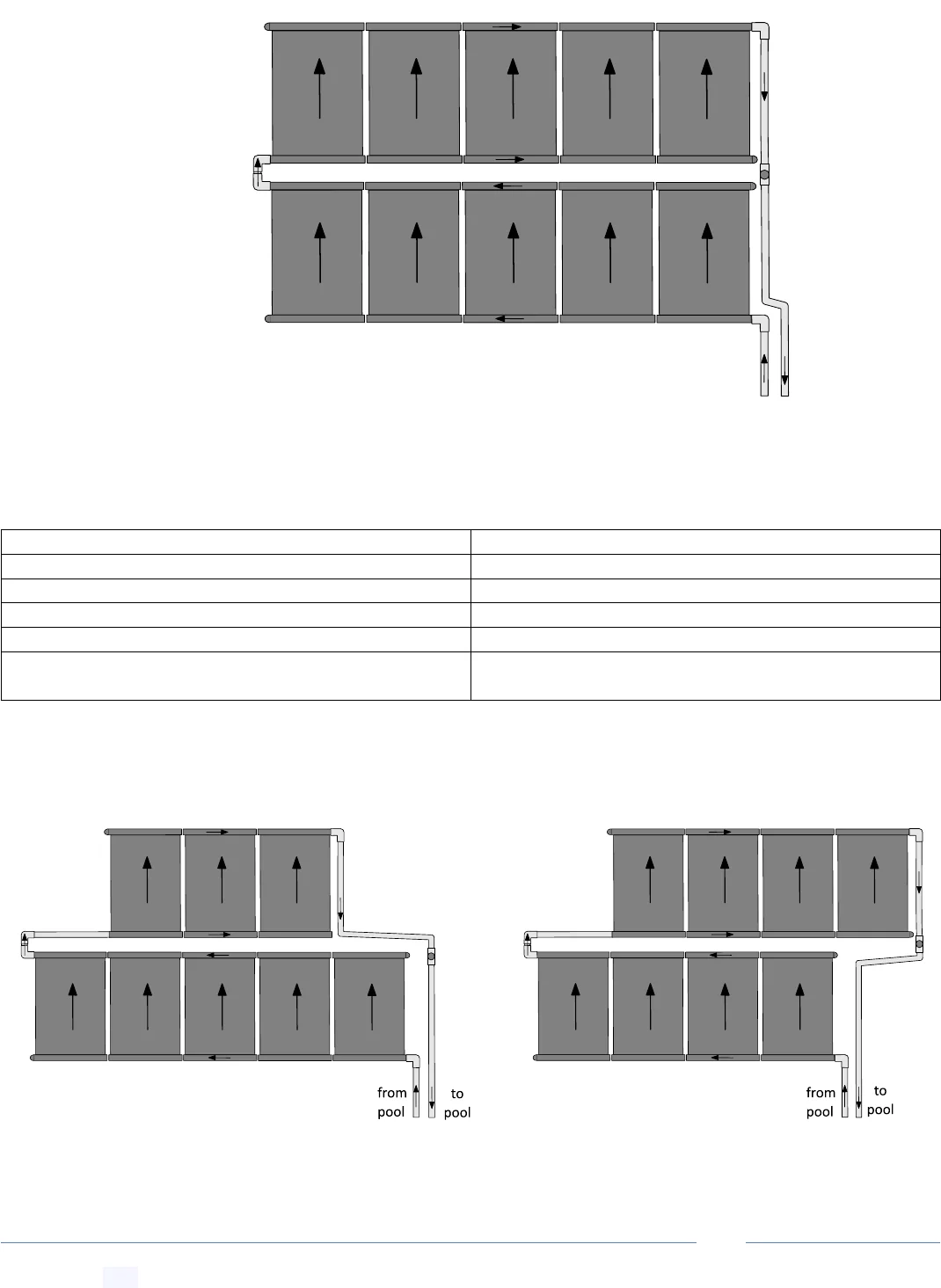
EcoOnline Performance+™ Solar Pool Heating System -- Installation & User Manual
© Copyright 2021 Optex Solar Pty Ltd. All rights strictly reserved.
Page 17
16.4 Two Row Serpentine Flow Configuration
Create jump link to this section-- Get Link
16.5 Parallel vs Serpentine Flow Configurations
Create jump link to this section-- Get Link
Parallel Configuration 17.3 (Recommended)
Serpentine 17.4 (Max: 100L/min, 20 Panels)
Splits flow - lower panel pressures
Higher panel pressures
Harder to plumb, more PVC bits
Easier to plumb but headers must be level
Better for larger panel per row arrays
Okay for arrays ≤10 per row
Okay for any pitch 2˚ (flat) - 90˚ (fence)
Okay for standard roof pitches between 5˚ to 35˚
Use for three or more row configurations
Not suited for three row configurations
(unless array has ≤ 20 panels)
16.6 Serpentine Flow for a Trapezoid or Parallelogram Array
Create jump link to this section-- Get Link
to
pool
from
pool
Suggested
configuration
limits:
~200L/min
~28 Panels
~35 Roof Pitch
o
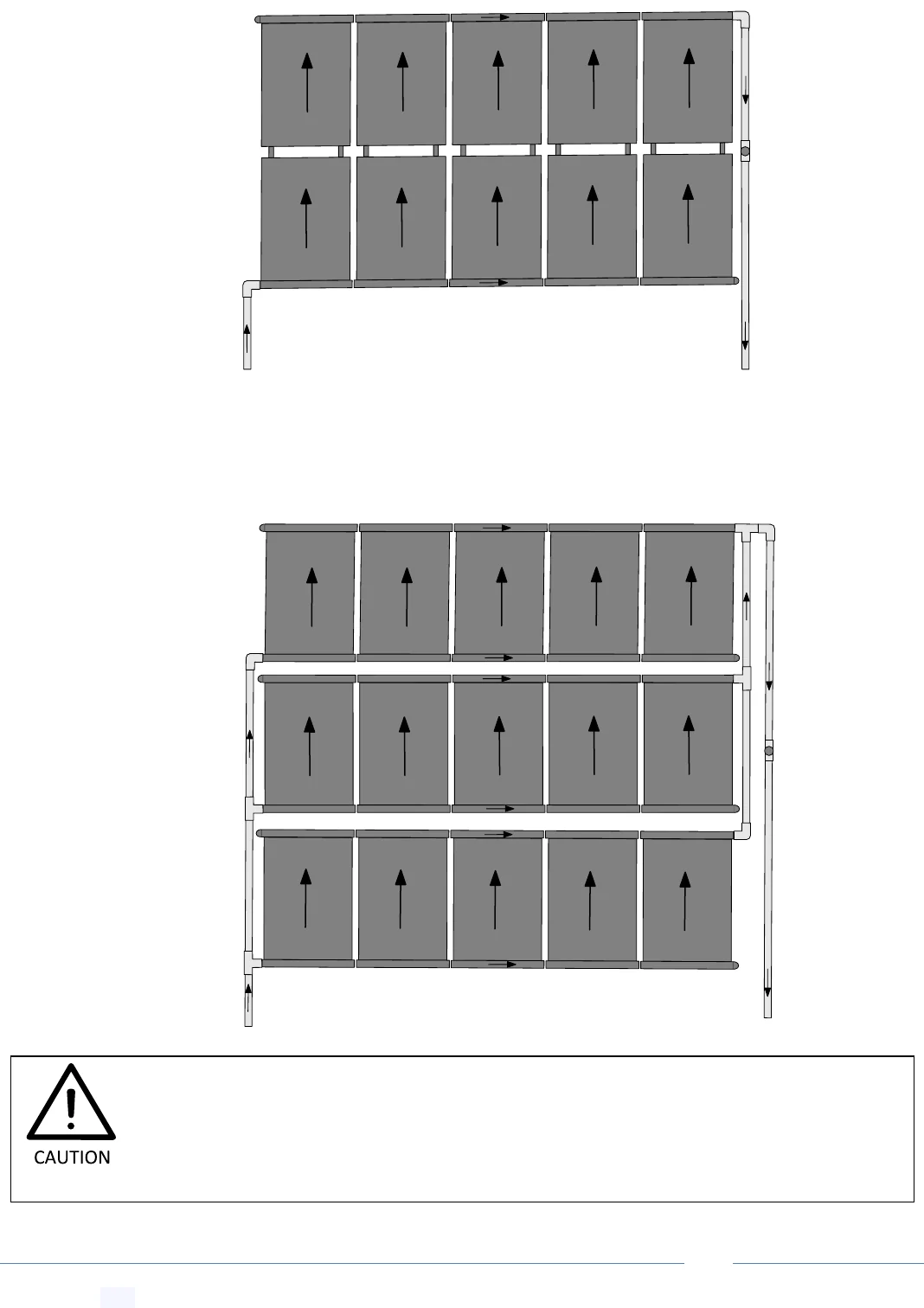
EcoOnline Performance+™ Solar Pool Heating System -- Installation & User Manual
© Copyright 2021 Optex Solar Pty Ltd. All rights strictly reserved.
Page 18
16.7 Interconnect Panel Flow Configuration
Create jump link to this section-- Get Link
16.8 Three Row In-Parallel Flow Configuration
Create jump link to this section-- Get Link
to
pool
from
pool
Suggested
configuration
limits:
~100L/min
~14 Panels
~45 Roof Pitch
o
to
pool
from
pool
Suggested
configuration
limits:
~300L/min
~42 Panels
~20 Roof Pitch
o
Please note: the bottom row of panels in a three row (or more) configuration installed on a
roof pitch greater than 20˚ will experience greater pressures. When carrying out the
Pressure Optimization Procedure in Section 27, we recommend setting the lowest positive
pressure possible.
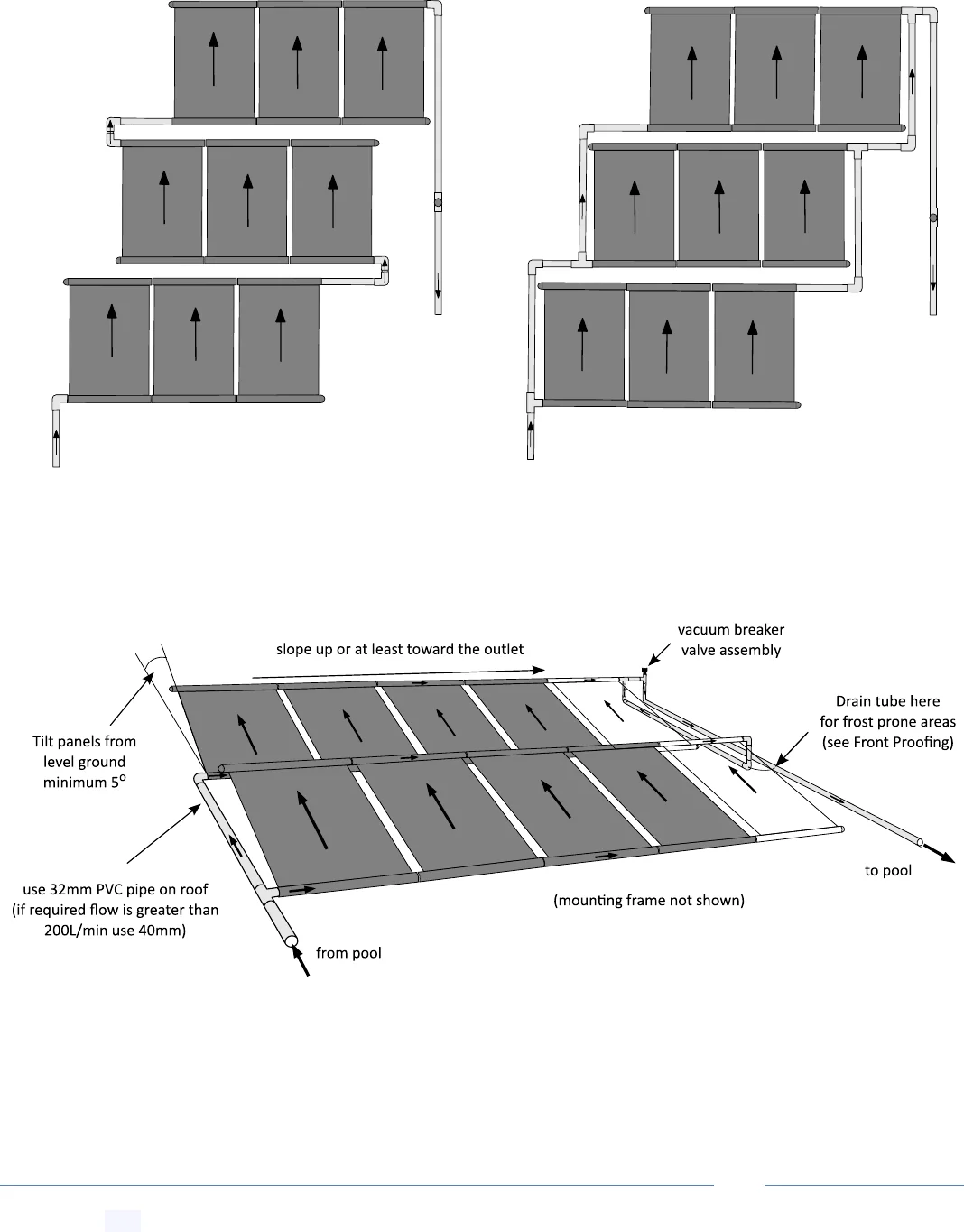
EcoOnline Performance+™ Solar Pool Heating System -- Installation & User Manual
© Copyright 2021 Optex Solar Pty Ltd. All rights strictly reserved.
Page 19
16.9 Staggered Array Flow Configurations
Create jump link to this section-- Get Link
16.10 Level Ground Mounting Configurations
Create jump link to this section-- Get Link
to
pool
from
pool
to
pool
from
pool
Suggested
configuration
limits:
~100L/min
~15 Panels
~20 Roof Pitch
Suggested
configuration
limits:
~300L/min
~42 Panels
~20 Roof Pitch
o
o
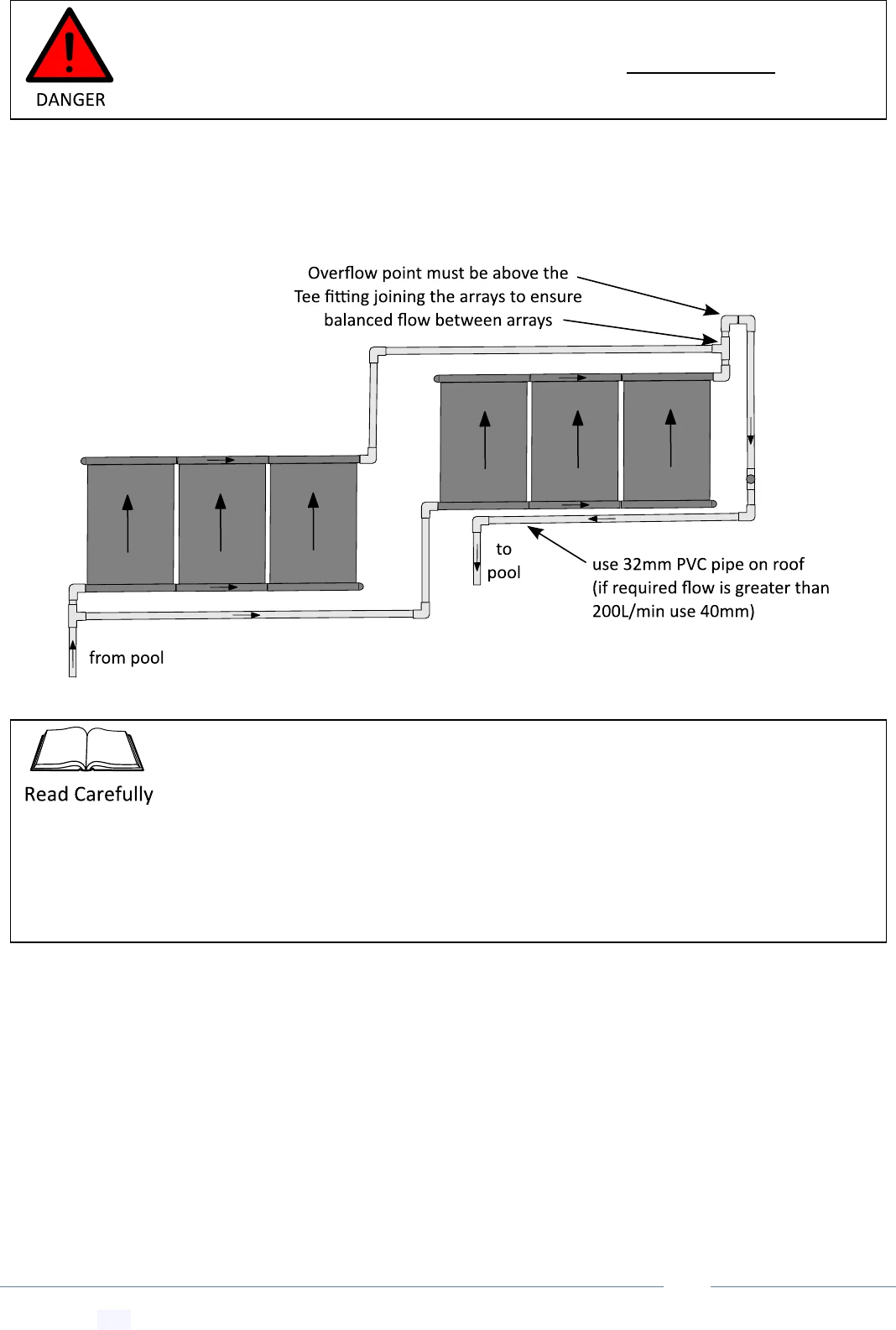
EcoOnline Performance+™ Solar Pool Heating System -- Installation & User Manual
© Copyright 2021 Optex Solar Pty Ltd. All rights strictly reserved.
Page 20
16.11 Split Array at Similar Height Levels
Create jump link to this section-- Get Link
16.12 Split Array at Substantially Different Heights
Create jump link to this section-- Get Link
For ground mounted arrays, under no circumstances should a collector array be mounted in
anyway so as to compromise the effectiveness of a pool or spa Child Safety Barrier.
Split collector arrays with a vertical height difference no more than 1m can use the
above configuration. Both array should be installed facing the same direction - or have
no more than 30˚ compass facing difference between them. In this later case the
temperature sensor should be installed at an angle that is an average of the two
collector array compass facing directions.
Why? Depending on the location of the roof sensor the controller could turn the system
on with one bank of collectors in full shade.

EcoOnline Performance+™ Solar Pool Heating System -- Installation & User Manual
© Copyright 2021 Optex Solar Pty Ltd. All rights strictly reserved.
Page 21
16.13 Bridging Obstructions, Expansion Joiners and Uneven Rows
Create jump link to this section-- Get Link
to
pool
from
pool
Air conditioner,
skylight or vent
32PVC bridging pipe section
( 2 x barb adapter + pipe)
PVC bridging pipe
section for uneven
number rows
thermal expension/contraction joiner
for array > 15 panels in length
Split collector arrays with a vertical height difference of greater than 1m MUST use the
above configuration with a constricting ball valve installed on the supply to the bottom
array to protect it from excessive pressure.
Why? Without the constricting ball valve the bottom array would receive all the water
flow.
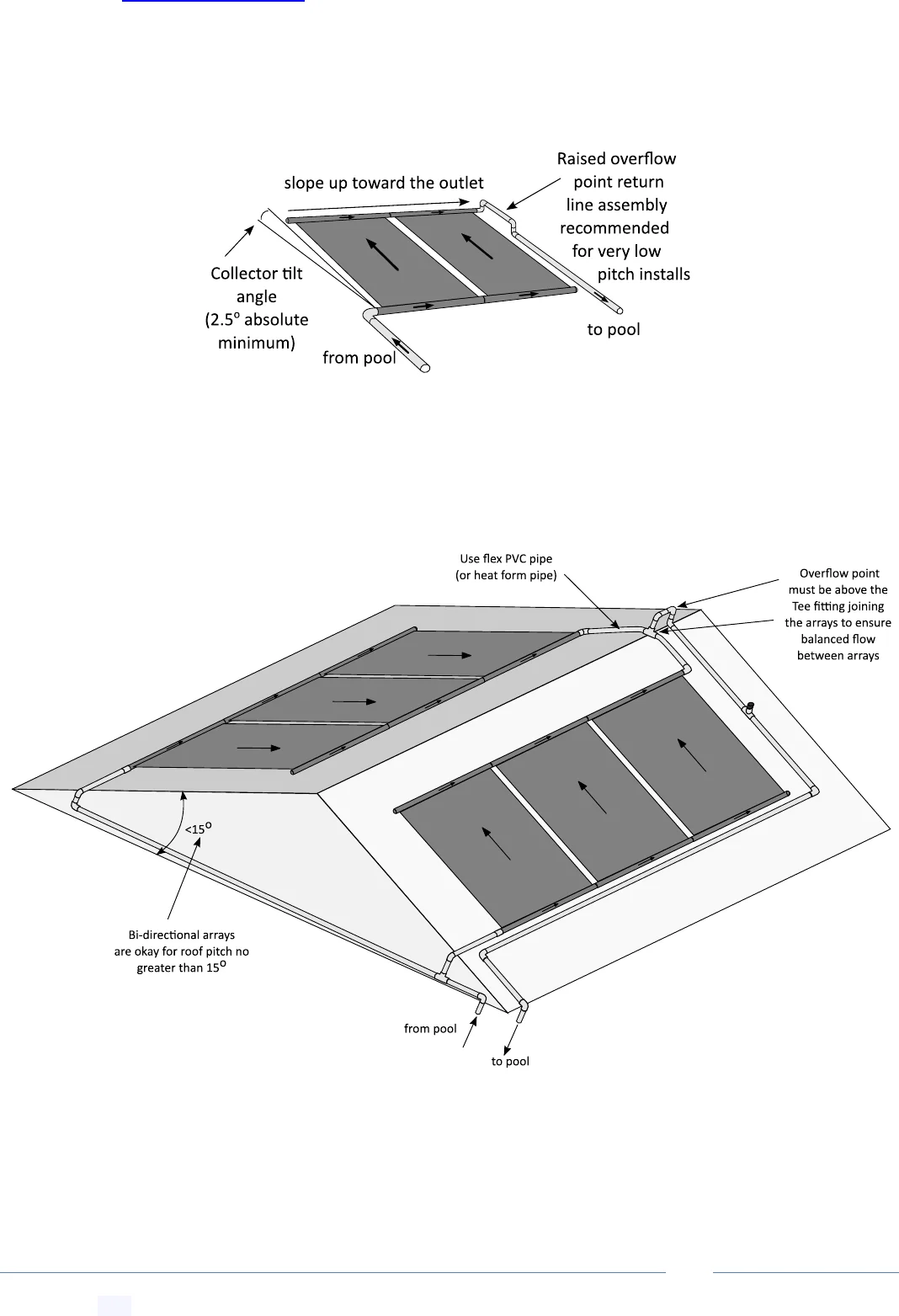
EcoOnline Performance+™ Solar Pool Heating System -- Installation & User Manual
© Copyright 2021 Optex Solar Pty Ltd. All rights strictly reserved.
Page 22
Please contact info@EcoOnline.com.au or visit our store for the special 316 slide expansion joiner for arrays that are
greater than 14 panels in a single row.
16.14 Return Line Configuration for Low Pitch Roof
Create jump link to this section-- Get Link
16.15 Preferred Bi-Directional Flow Configuration
Create jump link to this section-- Get Link
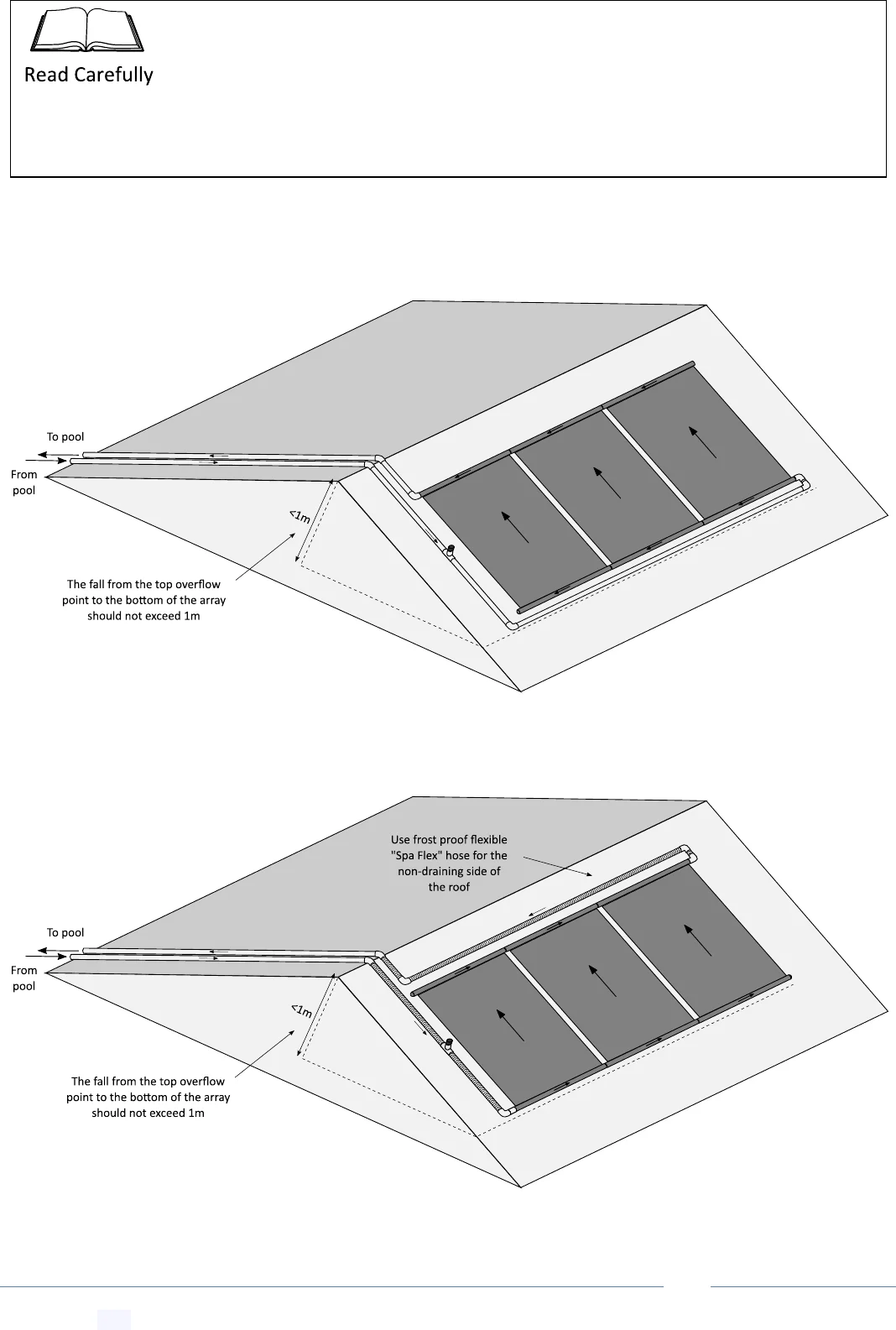
EcoOnline Performance+™ Solar Pool Heating System -- Installation & User Manual
© Copyright 2021 Optex Solar Pty Ltd. All rights strictly reserved.
Page 23
16.16 Top Feed Flow Configuration for Non-Frost Areas
Create jump link to this section-- Get Link
16.17 Top Feed Flow Configuration for Frost Areas
Create jump link to this section-- Get Link
Collector arrays that face opposing compass directions are not recommended unless
the roof pitch is less than ~15˚. In this case the temperature sensor should be installed
at an angle that is an average of the two collector array directions.
Why? Depending on the location of the roof sensor the controller could turn the system
on with one bank of collectors in full shade.
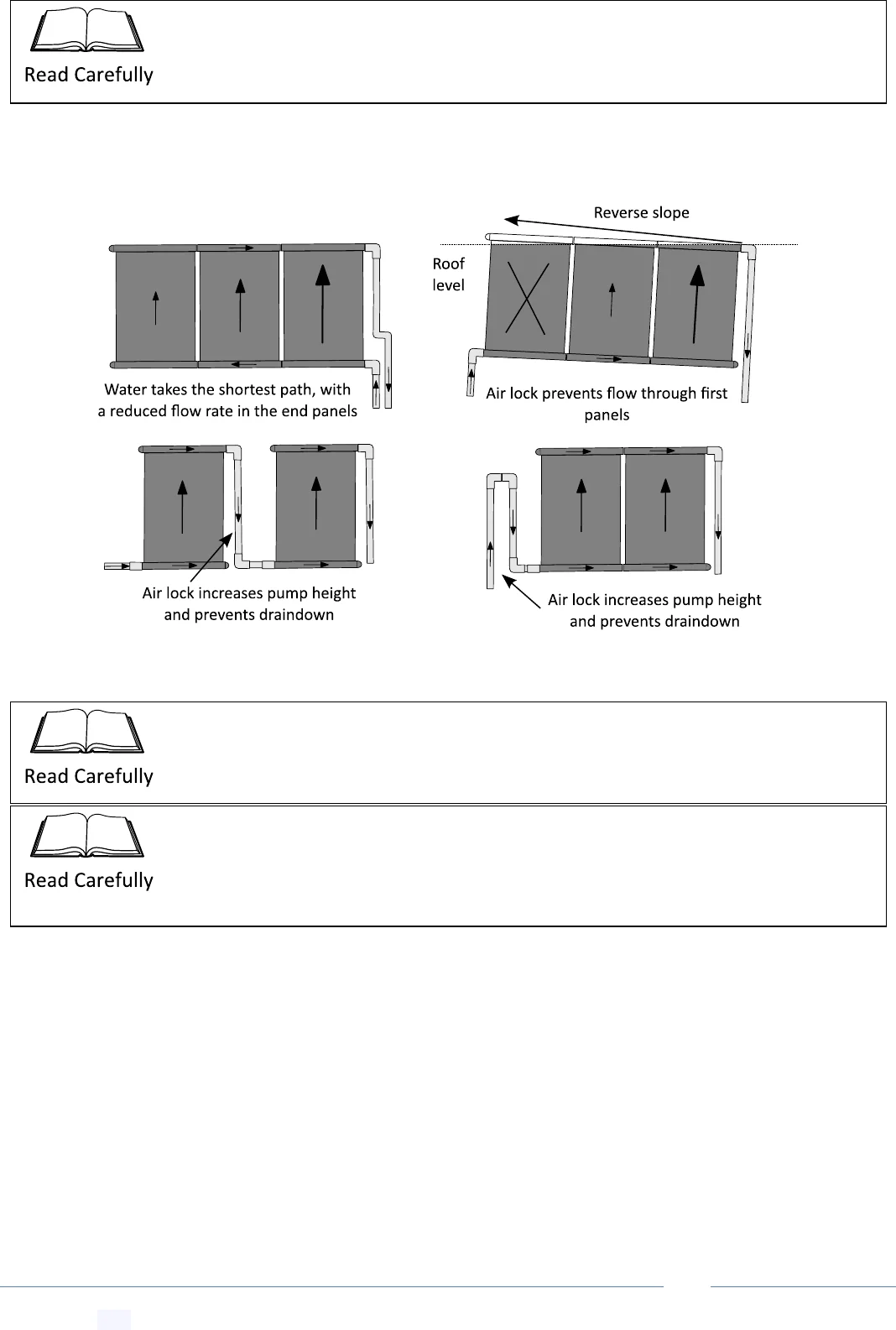
EcoOnline Performance+™ Solar Pool Heating System -- Installation & User Manual
© Copyright 2021 Optex Solar Pty Ltd. All rights strictly reserved.
Page 24
16.18 Plumbing Flow Configurations Not Recommended
Create jump link to this section-- Get Link
To make sure all air bubbles are evacuated upon filling collector should be installed
with a minimum recommended pitch of 3-5˚.
Ideally the collector array top header pipe should have a 1 to 2° upward slope toward
the outlet, to make sure all air is automatically removed from the entire array upon
filling. This is especially important for system with row containing 10 or more panels.
For frost prone areas the supply and return lines that runs over the top of the roof MUST
be run using UV rated “Spa Flex” hose (note Spa Flex hose requires special flexible PVC
glue).

EcoOnline Performance+™ Solar Pool Heating System -- Installation & User Manual
© Copyright 2021 Optex Solar Pty Ltd. All rights strictly reserved.
Page 25
17 Vacuum Release Location
Create jump link to this section-- Get Link
The vacuum release is a critical part of the system and must be installed for all collector
array greater than 0.5m above the water level.
Why? System without a vacuum release will experience large negative pressure working
forces as the pump stops and the water wants to fall back. The vacuum release on the
return line and the non-return on the supply line stop these pressure fluctuations.

EcoOnline Performance+™ Solar Pool Heating System -- Installation & User Manual
© Copyright 2021 Optex Solar Pty Ltd. All rights strictly reserved.
Page 26
18 Collector Panel Plumbing Connections
Create jump link to this section-- Get Link
BEFORE CUTTING - put aside two collectors per row with undamaged
end caps. For all remaining collectors cut the single end cap off using a
sharp blade or hacksaw.
Check all collector pipe connections for raised edges or grooves on the
weld lines which could channel water and cause leaks. Clean these up
using a blade and/or a heat gun on a high setting.
Check all barb edges are smooth and spherical to seal properly. For any
high or low points, warm the barb edge with a heat gun on high at 450°C
for 3-4 seconds, then slide over a 32 PVC (DN30) socket or 20 PVC (DN20)
socket for the smaller interconnect barb – this will knock down any high
points.
When installing silicon joiners the hose clamp band should be at the end
of the silicon joiner and not on the connector barbs. HAND TIGHTEN ONLY
using with an 8mm hex socket. Do not glue in silicon joiners. (Pinhole
leaks can be sealed with a little silicon). You may need to slightly re-
tighten these with cool water running through the collectors at a later
stage, as HDPE has a high thermal contraction.
The barb end of inlet/outlet PVC adapter should be glued into the 40mm
silicon joiner with any neutral cure silicon as shown.
Why? PVC barbs can soften at extreme roof stagnation temperatures and
contract slightly with clamp pressure. HDPE, on the other hand, will not
soften significantly at the maximum roof stagnation temperature of ~80˚C.
The non-barb end of inlet/outlet PVC adapter should be glued into 32 PVC
(DN30) sockets.
Note: some 32 PVC (DN30) socket brands are non-standard and are quite
loose with our adapters, if so apply a layer of PVC glue and let dry for 1
hour prior to final socket gluing or use a filler PVC glue.
Laceration hazard: Always cut away from your
body and ensure no parts of the body are in front
of the cutting blade.
Any misshapen barbs can be warmed to 150°C
with a heat gun to reform.
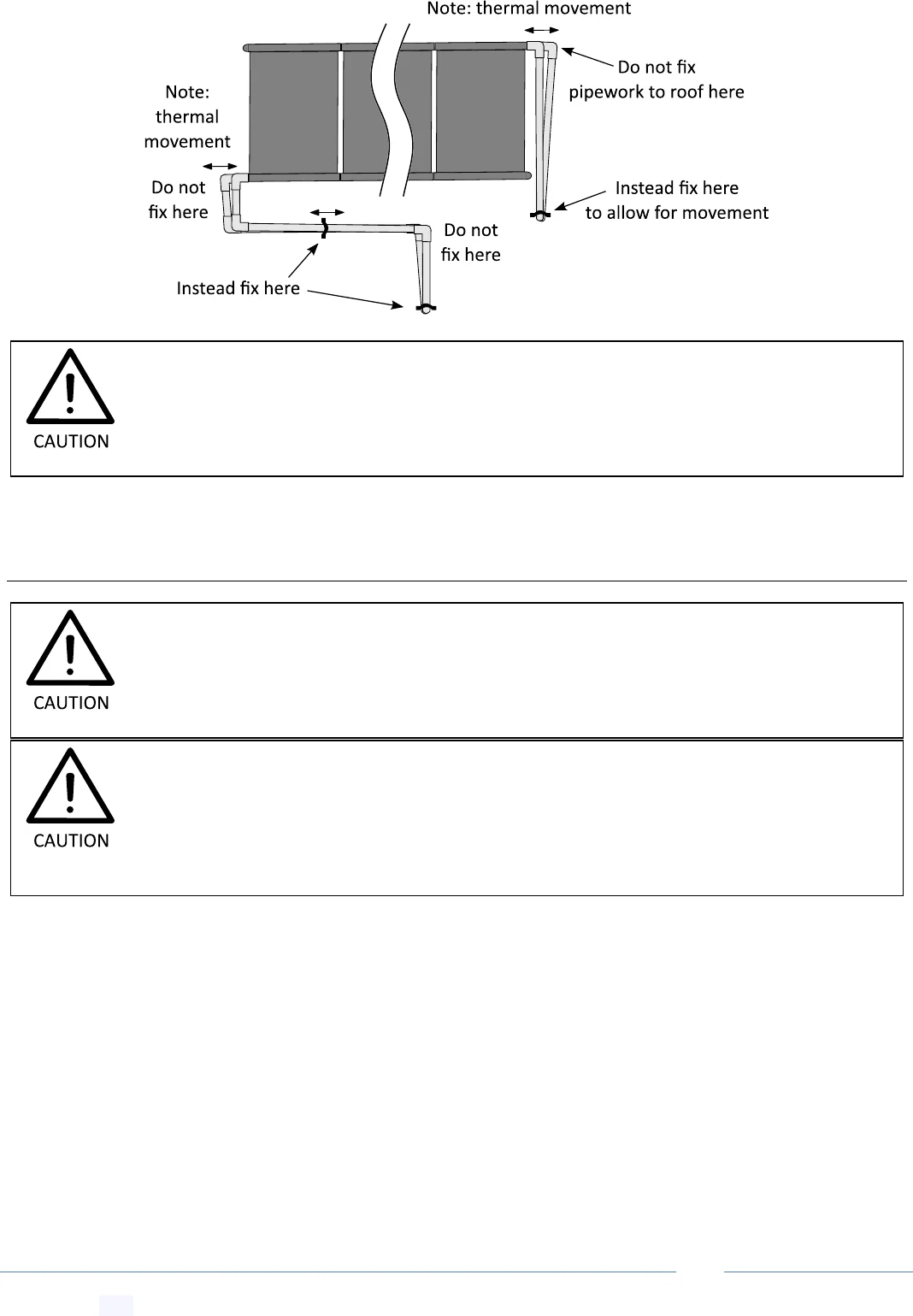
EcoOnline Performance+™ Solar Pool Heating System -- Installation & User Manual
© Copyright 2021 Optex Solar Pty Ltd. All rights strictly reserved.
Page 27
18.1 PVC Pipe Roof Fixings
Create jump link to this section-- Get Link
19 Array Roof Fixing Configurations
Create jump link to this section-- Get Link
Note the high thermal contraction and natural relaxation of HDPE: Collectors will contact (in
length) by up to 10mm over time and 12mm thermally across temperature extremes. Hence
any fixing means must account for an ultimate contraction of 22mm in length per panel.
Key design principles when choosing a roof mounting means:
1) Consider the high thermal contraction of HDPE
2) Panels should be as low down on the roof as possible to prevent the wind from
catching the underside of panels
3) The stainless steel straps must allow for thermal movement of panels.
Note the large thermal movement in the array inlets and outlets (depending on how panels
you have in one row). PVC pipe work should NOT be fixed to the roof near the inlets and
outlets, but should be allowed to move with the collector array.
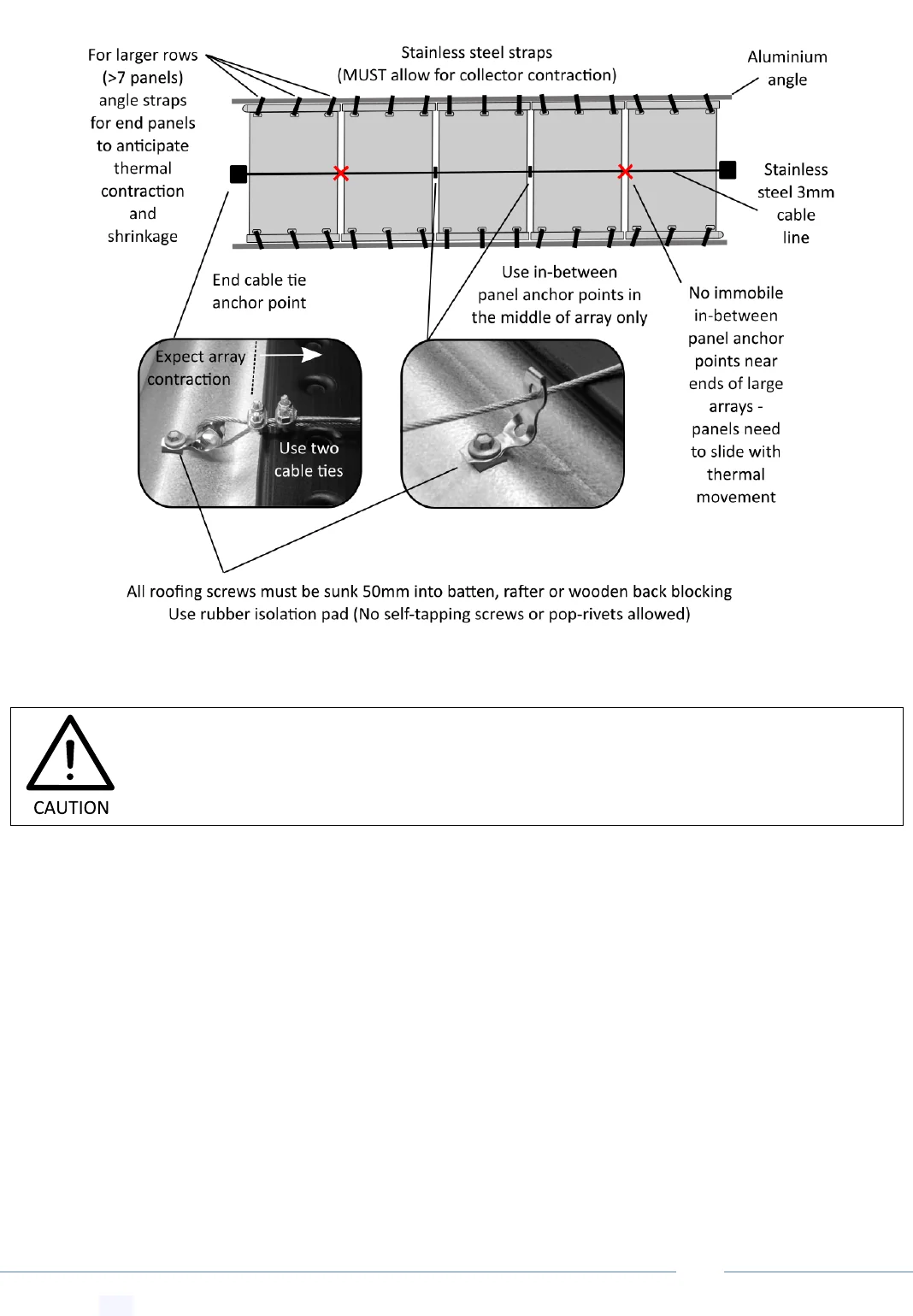
EcoOnline Performance+™ Solar Pool Heating System -- Installation & User Manual
© Copyright 2021 Optex Solar Pty Ltd. All rights strictly reserved.
Page 28
19.1 Single or Multi-Row Metal Roof Fixings Wind Region A
Create jump link to this section-- Get Link
For row arrays exceeding 15 panels per row, expansion joiners MUST be used (contact
info@EcoOnline.com.au)
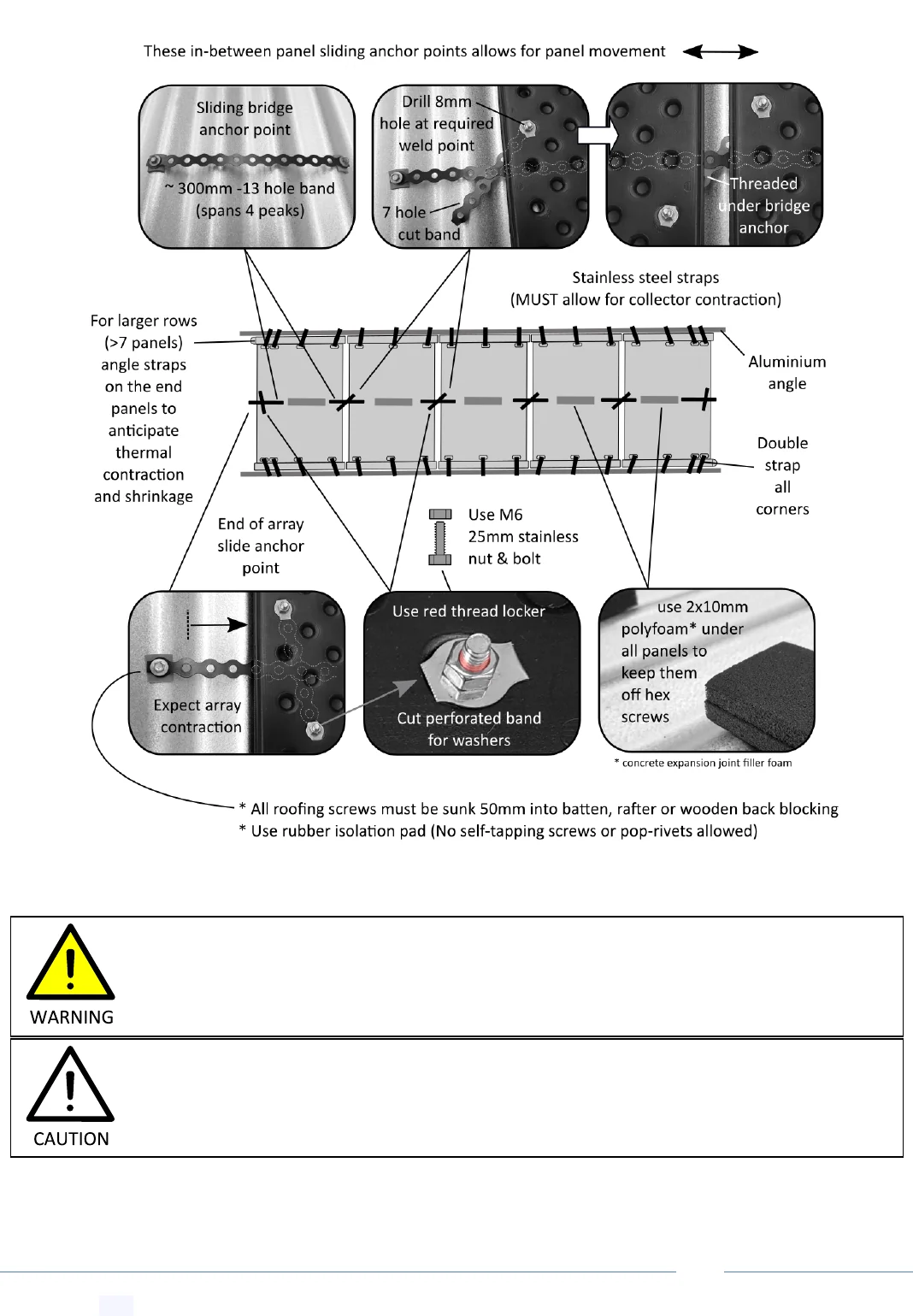
EcoOnline Performance+™ Solar Pool Heating System -- Installation & User Manual
© Copyright 2021 Optex Solar Pty Ltd. All rights strictly reserved.
Page 29
19.2 Single or Multi-Row Metal Roof Fixings for Wind Regions B & C
Create jump link to this section-- Get Link
NOTE: For single or multi-row arrays in wind regions B or C, aluminium L-angle MUST be
installed for top and bottom of each row. Mid-panel attachments must also be installed.
For row arrays exceeding 15 panels per row, expansion joiners MUST be used (contact
info@EcoOnline.com.au)

EcoOnline Performance+™ Solar Pool Heating System -- Installation & User Manual
© Copyright 2021 Optex Solar Pty Ltd. All rights strictly reserved.
Page 30
19.3 Single or Multi-Row Tile Roof Fixings for Wind Region A & B
Create jump link to this section-- Get Link
For single or multi-row arrays in wind regions B, aluminium L-angle MUST be run for the
top and bottom of each row.
For row arrays exceeding 15 panels per row, expansion joiners MUST be used (contact
info@EcoOnline.com.au)
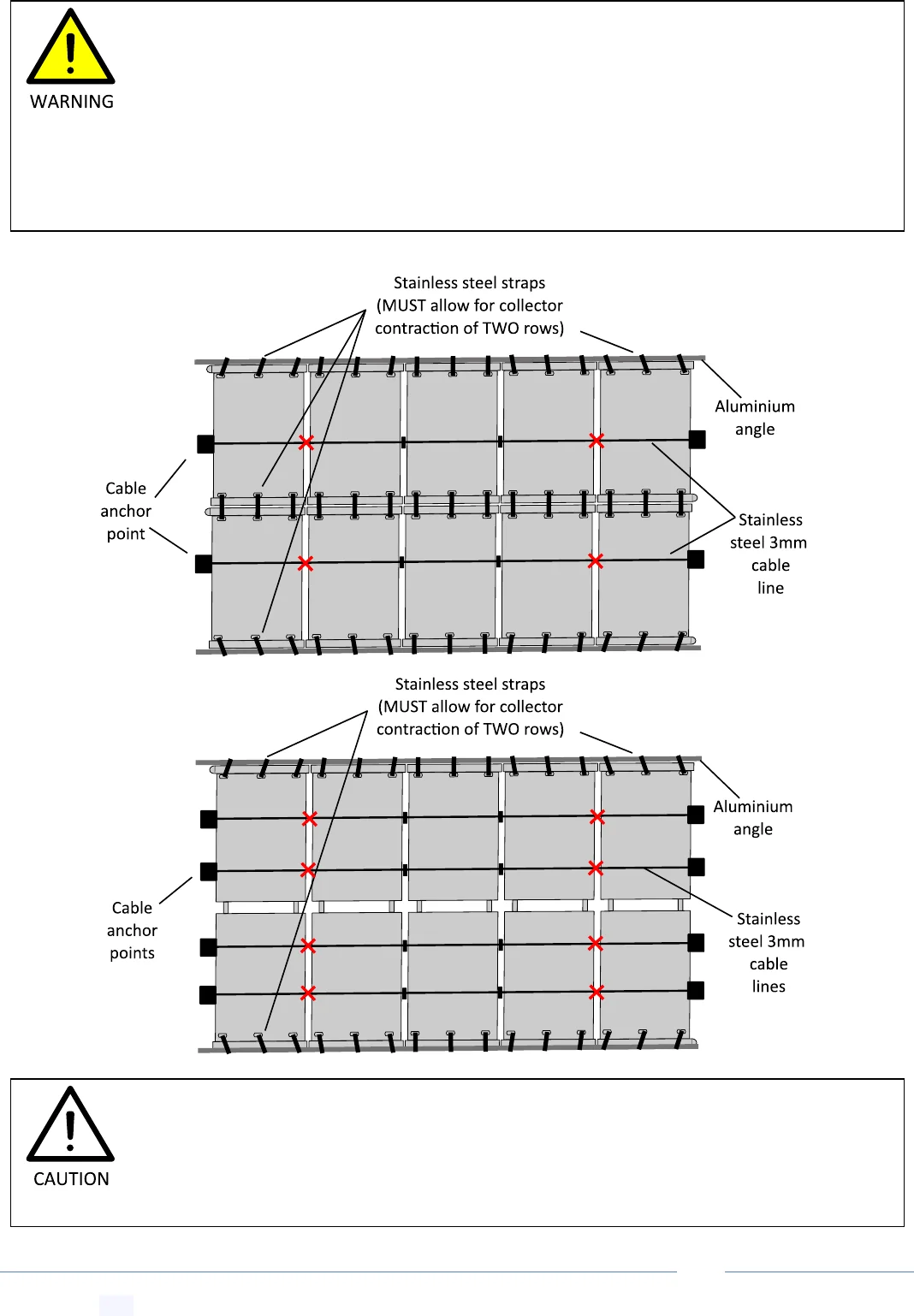
EcoOnline Performance+™ Solar Pool Heating System -- Installation & User Manual
© Copyright 2021 Optex Solar Pty Ltd. All rights strictly reserved.
Page 31
19.4 Low Wind Area Alternate Two Row Roof Fixings
Create jump link to this section-- Get Link
Allowed for Region A, Terrain 3 Wind Loadings ONLY
Installation of two rows between two aluminium angles will require twice the expansion gap in
the stainless steel straps. We also highly recommend you “season” the panels before
installation to removed some of the permanent contraction the panels are prone to.
“Seasoning” the panels involves laying the panels out in the sun for half a day on one
side, then flipping over for the other side.
For dual row array fixed between top and bottom array aluminium channels, do not exceed
10 panels per row. If you need to have more than 10 panels we recommend each row have
aluminium railings. Why? Panels strapped top and bottom to an aluminium railing will have
smaller side to side thermal movements.

EcoOnline Performance+™ Solar Pool Heating System -- Installation & User Manual
© Copyright 2021 Optex Solar Pty Ltd. All rights strictly reserved.
Page 32
19.5 Application of the PVC Coated Stainless Steel Straps
Create jump link to this section-- Get Link
19.6 Three or More Row Roof Fixings
Create jump link to this section-- Get Link
Due to the large potential thermal contraction across three rows the strapping of three
or more rows of panels between one set of fixed top and bottom aluminium angles is not
recommended. Collector arrays consisting of three or more rows must have a pair of
aluminium L-angles top and bottom for each row of collectors or at least for each pair of
rows to allow for contraction.
IMPORTANT: DO NOT over tighten stainless
steel strapping. Strapping must have sufficient
play to allow for collector contraction. For the
installation of two rows between two
aluminium channels top and bottom strapping
should be loose enough to insert your little
finger between the strapping and the header
pipe. Why? Over-tightened straps can
experience tension and continual flexing of the
metal due to the thermal contraction of the
collectors. This can result in metal fatigue of
roof fixings over time.

EcoOnline Performance+™ Solar Pool Heating System -- Installation & User Manual
© Copyright 2021 Optex Solar Pty Ltd. All rights strictly reserved.
Page 33
20 Tile Roof Aluminium Angle Mounting Options
Create jump link to this section-- Get Link
20.1 Top Panel Tile Attachment
Create jump link to this section-- Get Link
For tile roofs we recommend using a minimum roof hook spacing of 600mm in the top and
bottom row. Depending on your wind loading (see “Wind Proofing” section), angle of install
you may require a higher density of roof hooks and/or a stronger Aluminium L-angle, if unsure
please seek advice.
The collectors can be walked on without damage, however for tile roofs with solar roof hook
care should be taken not to step on or near a roof hook as you may crack a tile.
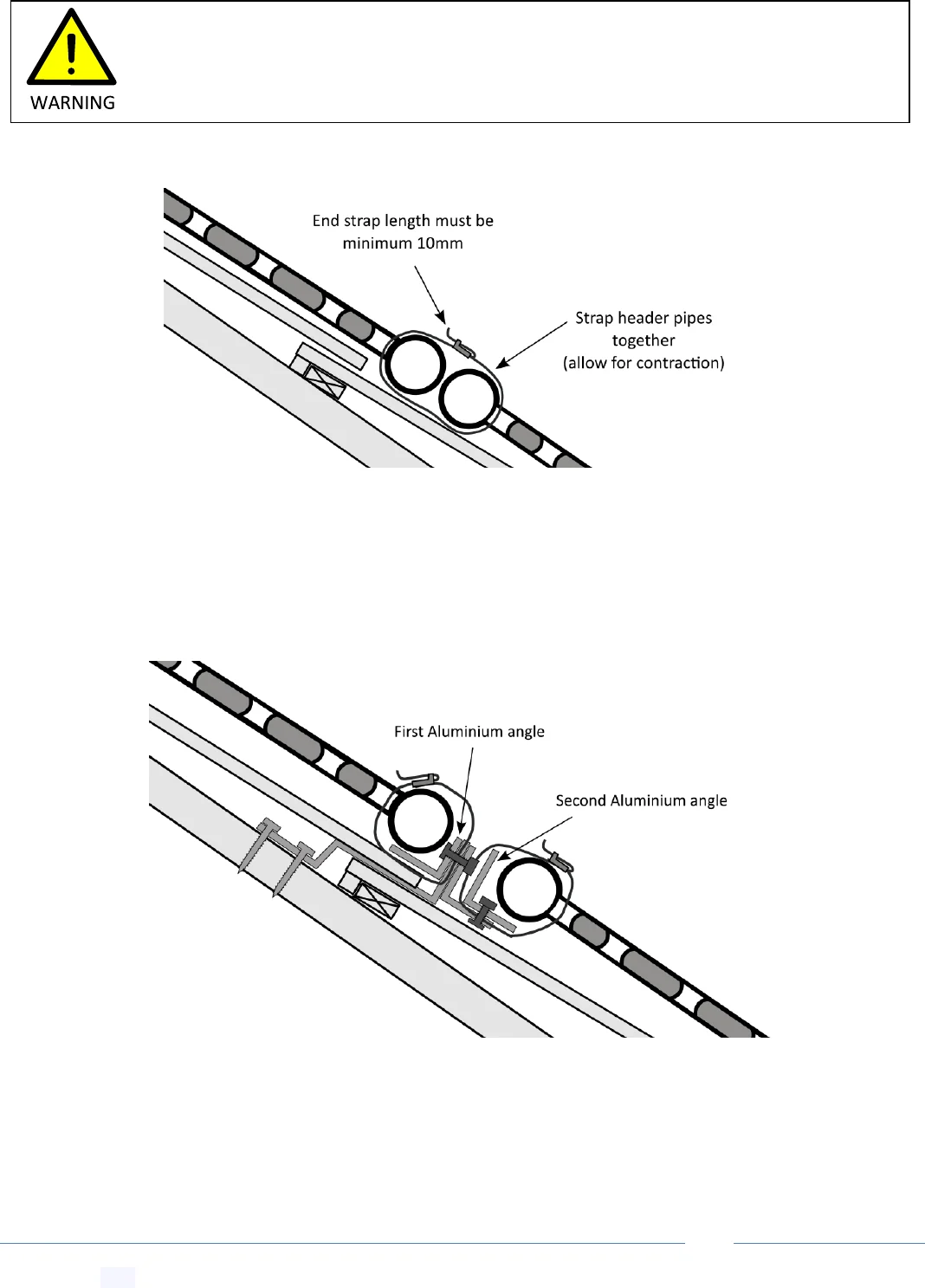
EcoOnline Performance+™ Solar Pool Heating System -- Installation & User Manual
© Copyright 2021 Optex Solar Pty Ltd. All rights strictly reserved.
Page 34
20.2 Two Row Panel to Panel Attachment
Create jump link to this section-- Get Link
20.3 Two Row Mid Array Panel Attachment – Dual Aluminium Angle
Create jump link to this section-- Get Link
Region A, Terrain 3 Wind Loadings ONLY

EcoOnline Performance+™ Solar Pool Heating System -- Installation & User Manual
© Copyright 2021 Optex Solar Pty Ltd. All rights strictly reserved.
Page 35
20.4 Two Row Mid Array Panel Attachment - Single Aluminium Angle
Create jump link to this section-- Get Link
20.5 Bottom Panel Tile Attachment
Create jump link to this section-- Get Link

EcoOnline Performance+™ Solar Pool Heating System -- Installation & User Manual
© Copyright 2021 Optex Solar Pty Ltd. All rights strictly reserved.
Page 36
20.6 Stainless Steel Cable Anchor Point Option
Create jump link to this section-- Get Link
20.7 Perforated Band Under-Tile Anchor Point
Create jump link to this section-- Get Link
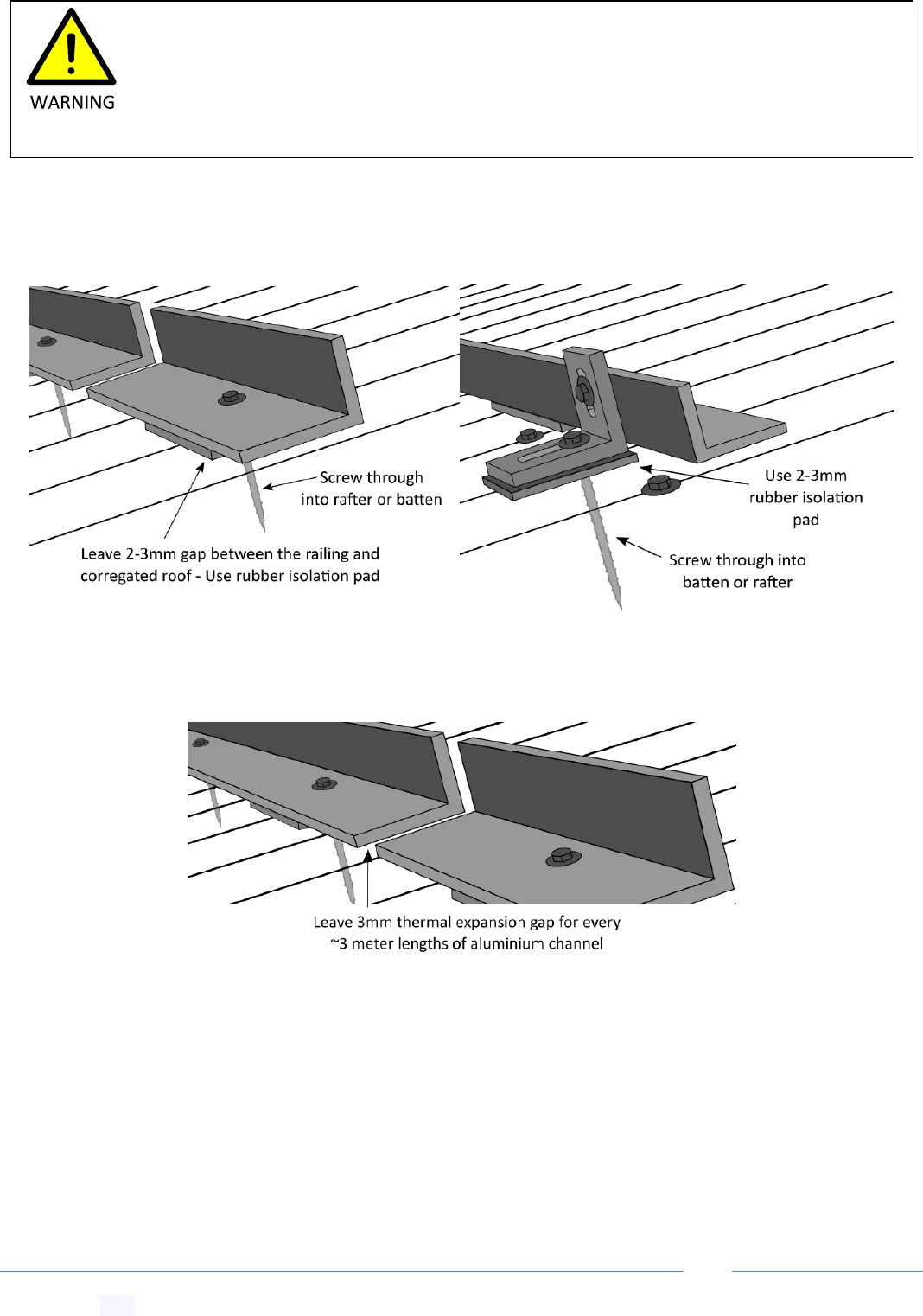
EcoOnline Performance+™ Solar Pool Heating System -- Installation & User Manual
© Copyright 2021 Optex Solar Pty Ltd. All rights strictly reserved.
Page 37
21 Corrugated Metal Roof Mounting Options
Create jump link to this section-- Get Link
21.1 Mounting Options for Top or Bottom Angle Rail
Create jump link to this section-- Get Link
21.2 Thermal Expansion Gaps for Aluminium Channels
Create jump link to this section-- Get Link
For metal roofs we recommend using a minimum screw fixing space of 600mm when fixing
the aluminium angle. Depending on your wind loading (see “Wind Proofing” section), angle of
install, you may require a higher density of fixings and/or a stronger Aluminium angle, if
unsure please seek advice.
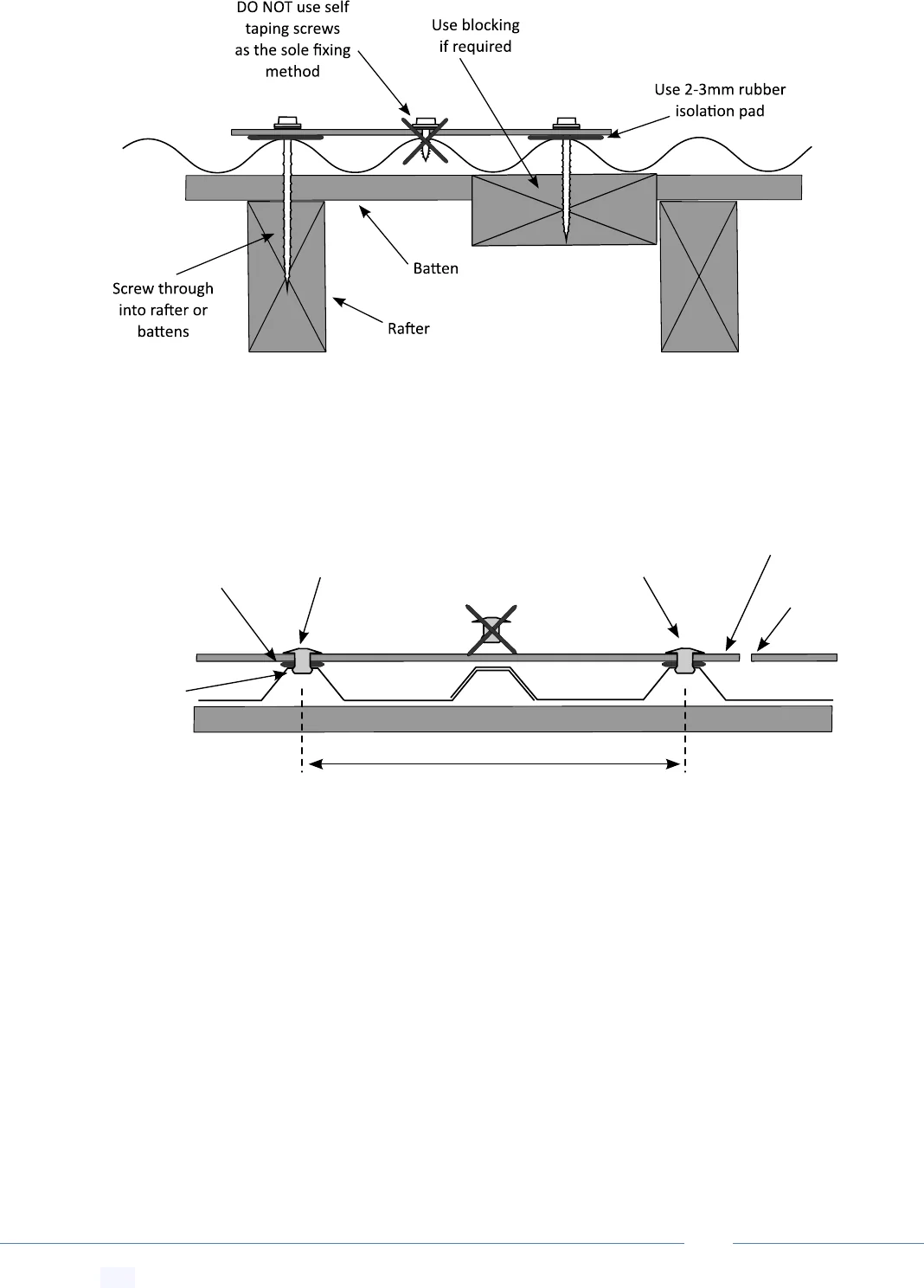
EcoOnline Performance+™ Solar Pool Heating System -- Installation & User Manual
© Copyright 2021 Optex Solar Pty Ltd. All rights strictly reserved.
Page 38
21.3 Metal Roof Screw Selection and Method
Create jump link to this section-- Get Link
21.4 Metal Roof Rivet Fixing Method for Wind Region A Only
Create jump link to this section-- Get Link
Use isolation pad
with silicon sealent
top and bottom
DO NOT rivet
overlap sections
Batten
Use 6.4mm body
diameter aluminium
rivets
Aluminium L-angle
(use max 2m lengths)
Leave 2-3mm
expansion gap
to next section
Space rivets ~250mm apart
Use silicon sealent
top and bottom
of rivet
After drilling hole
in roof profile wipe
silicon sealent on
the inside edge
(use hooked cotten bud)
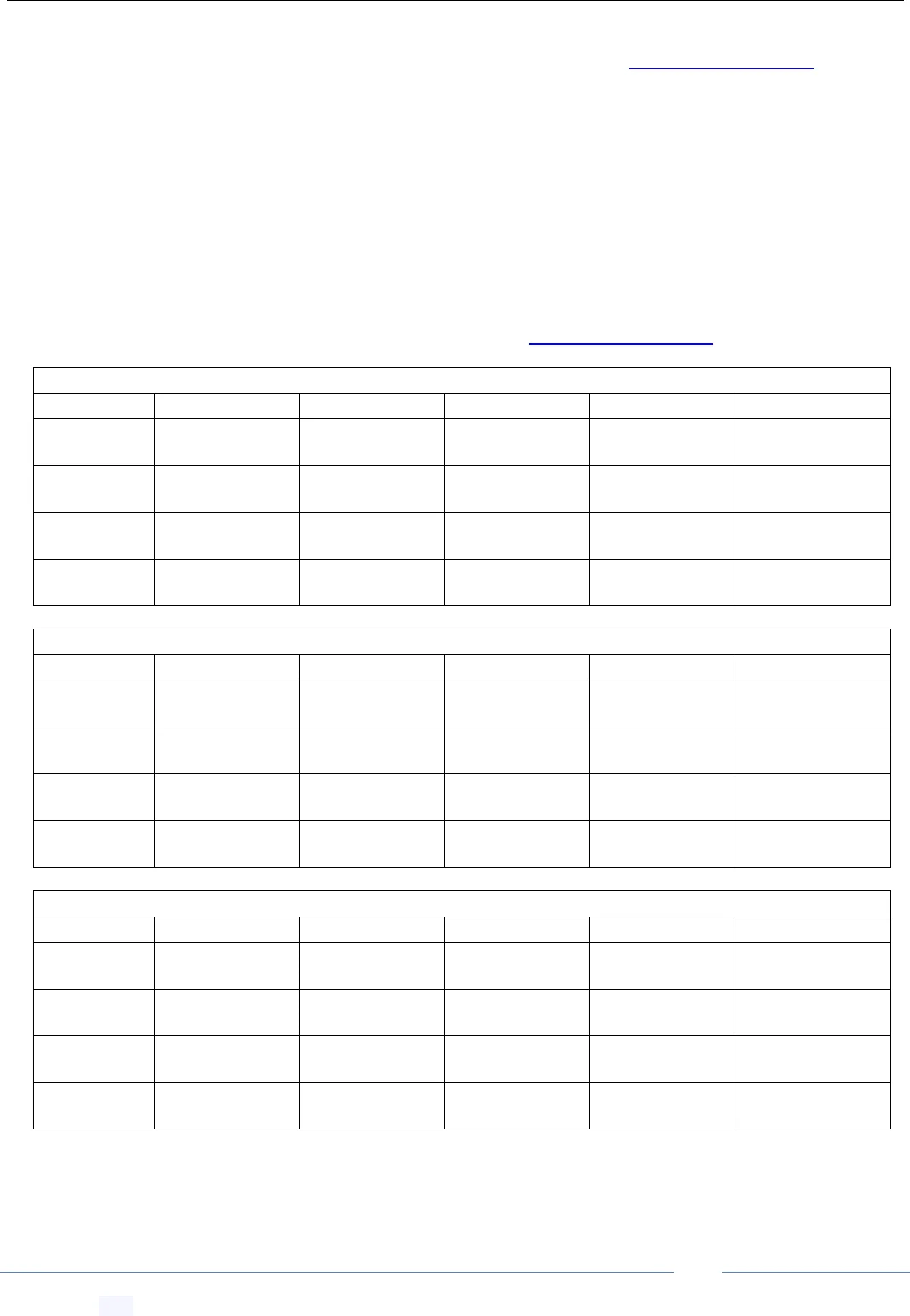
EcoOnline Performance+™ Solar Pool Heating System -- Installation & User Manual
© Copyright 2021 Optex Solar Pty Ltd. All rights strictly reserved.
Page 39
22 Wind Proofing
Create jump link to this section-- Get Link
Note: roof installation of these panels in Wind Region D is not recommended. This section provides general advice
on wind loadings. If you have any doubt about your wind loadings please contact info@EcoOnline.com.au
22.1 Ultimate Peak Wind Loadings per Panel
Create jump link to this section-- Get Link
The following Tables specify the ultimate peak uplift any single panel can experience in a 1 in 500 year extreme
storm or cyclone event according to Australian Standard 1170.2 - 2011 (Amend 2 Dec 2012). These tables assume:
1) Panels are mounted on (touching) the roof structure - or no more than 20mm off the roof surface
2) Panels are situated away from a roof edge or corner
3) Installation is on a first story roof
4) Shortest side length of the building is more than twice the average building height (i.e. flat building)
If your installation falls outside of these assumptions please contact info@EcoOnline.com.au for alternative loadings.
Ultimate Peak Uplift Loadings Per Panel in Wind Region A (Kg)
Region A
< 10˚ Roof Pitch
12.5˚ Roof Pitch
15˚ Roof Pitch
17.5˚ Roof Pitch
> 20˚ Roof Pitch
Terrain
Category 1
120 Kg
110 Kg
95 Kg
90 Kg
80 Kg
Terrain
Category 2
100 Kg
90 Kg
80 Kg
70 Kg
65 Kg
Terrain
Category 2.5
90 Kg
80 Kg
70 Kg
65 Kg
60 Kg
Terrain
Category 3
85 Kg
75 Kg
65 Kg
60 Kg
55 Kg
Ultimate Peak Uplift Loadings Per Panel in Wind Region B (Kg)
Region B
< 10˚ Roof Pitch
12.5˚ Roof Pitch
15˚ Roof Pitch
17.5˚ Roof Pitch
> 20˚ Roof Pitch
Terrain
Category 1
195 Kg
175 Kg
150 Kg
140 Kg
130 Kg
Terrain
Category 2
160 Kg
145 Kg
125 Kg
115 Kg
105 Kg
Terrain
Category 2.5
150 Kg
130 Kg
115 Kg
105 Kg
100 Kg
Terrain
Category 3
135 Kg
120 Kg
105 Kg
95 Kg
90 Kg
Ultimate Peak Uplift Loadings Per Panel in Wind Region C (Kg)
Region C
< 10˚ Roof Pitch
12.5˚ Roof Pitch
15˚ Roof Pitch
17.5˚ Roof Pitch
> 20˚ Roof Pitch
Terrain
Category 1
290 Kg
255 Kg
225 Kg
210 Kg
190 Kg
Terrain
Category 2
240 Kg
215 Kg
185 Kg
170 Kg
160 Kg
Terrain
Category 2.5
220 Kg
195 Kg
170 Kg
155 Kg
145 Kg
Terrain
Category 3
200 Kg
175 Kg
155 Kg
145 Kg
130 Kg
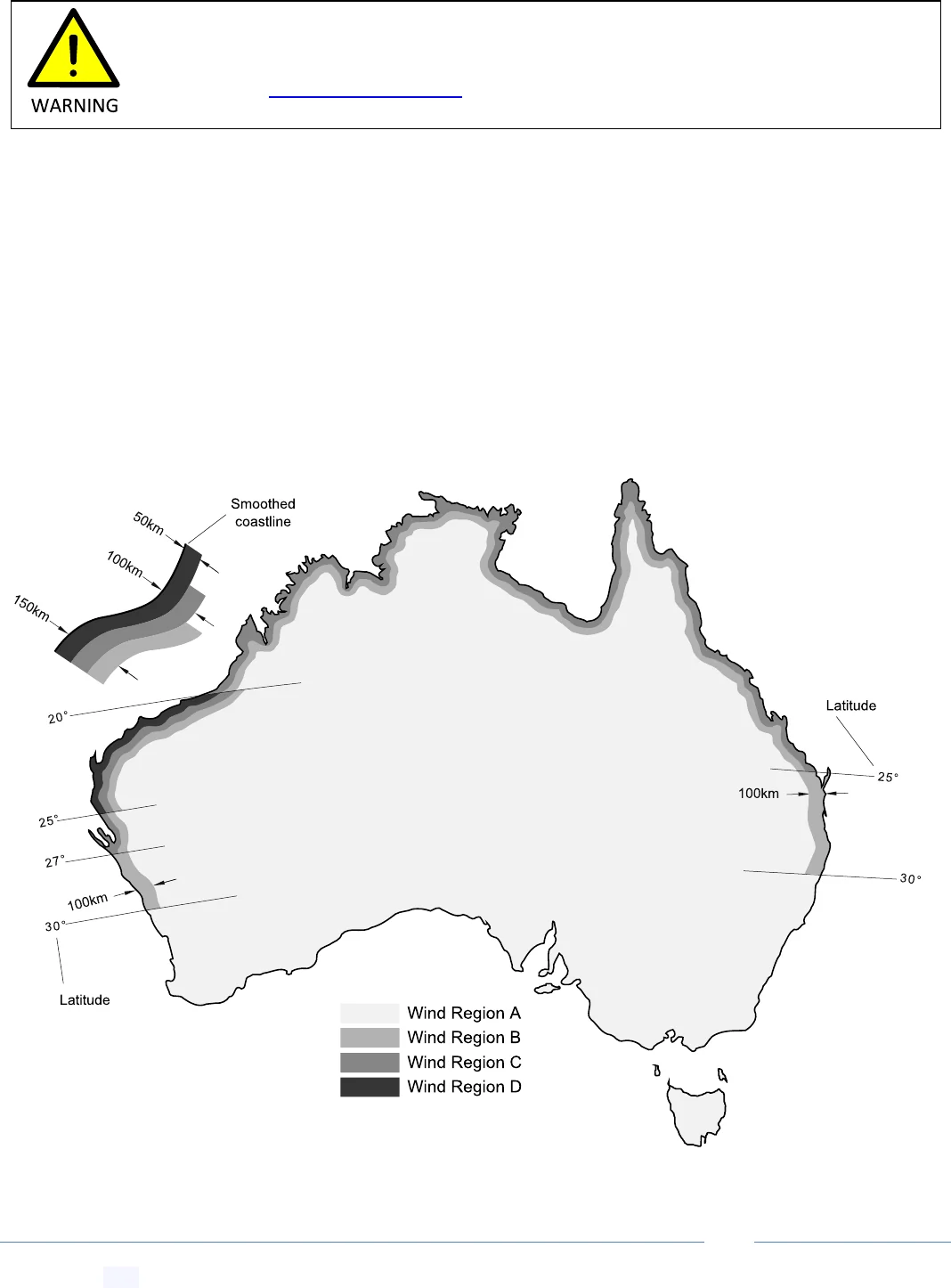
EcoOnline Performance+™ Solar Pool Heating System -- Installation & User Manual
© Copyright 2021 Optex Solar Pty Ltd. All rights strictly reserved.
Page 40
As an example if you are in Wind Region B and Terrain Category 3 and have a roof pitch 12.5˚ then any single panel
in your collector system could experience momentary peak uplifts of ~120Kg per panel. You should make sure your
panels and fixing components can withstand your relevant loadings. See below for Terrain Category definitions.
22.2 Terrain Category Definitions
Create jump link to this section-- Get Link
Terrain Category 1: Open terrain few obstructions. Example flat, treeless, poorly grassed plains.
Terrain Category 2: Open terrain with scattered obstructions having heights from 1 .5m to 5m, with at
least two building type obstructions per hectare. Example farmland and cleared subdivisions with
isolated trees.
Terrain Category 2.5: Averaged intermediate between Terrain Category 2 and Terrain Category 3
Terrain Category 3: Numerous closely spaced building obstructions having heights from 3m to 10m with
at least 10 house-size obstructions per hectare. For example a fully developed suburb or light industrial
estates.
22.3 Wind Region Definitions
Create jump link to this section-- Get Link
Coastal region boundaries are smooth lines set in from a smoothed coastline by 50km, 100km or 150km lines.
Note: Installations involving a second story roof or higher, or houses on hills, or panels
mounted 50mm or greater above the roof structure have higher potential wind loadings.
Please contact info@EcoOnline.com.au for ultimate wind loadings based on your details.

EcoOnline Performance+™ Solar Pool Heating System -- Installation & User Manual
© Copyright 2021 Optex Solar Pty Ltd. All rights strictly reserved.
Page 41
22.4 Frequency of Extra Fixings for Different Regions
Create jump link to this section-- Get Link
For ultimate wind loadings
(see Tables above):
Extra Fixings Required
Less than 70Kg per panel
Stainless guide line is not required (but still recommended)
Greater than 70Kg per panel
Stainless guide line is required across each row
Greater than 120kg per panel
Stainless guide line is required with in-between anchor points
22.5 Roof Edge High Wind Loading Zones
Create jump link to this section-- Get Link
Note: Collector installations within a roof edge high wind loading zone will require 2 X the
fixing strength in that local area. Collector installations within a roof corner high wind loading
zone will require 3 X the fixing strength in that local area.
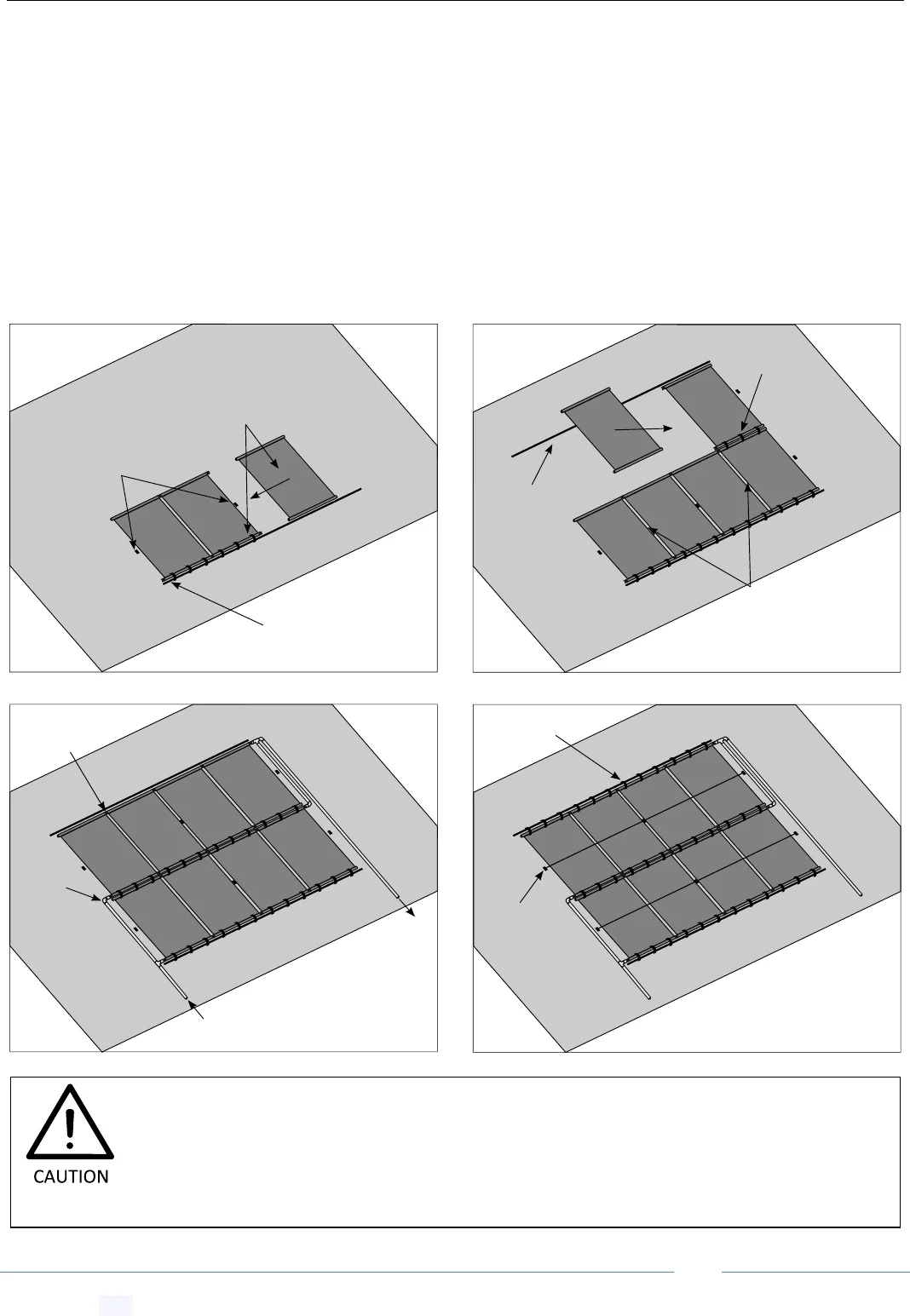
EcoOnline Performance+™ Solar Pool Heating System -- Installation & User Manual
© Copyright 2021 Optex Solar Pty Ltd. All rights strictly reserved.
Page 42
23 Seasoning Panels and Minimizing Contraction Issues
Create jump link to this section-- Get Link
Please be aware, collectors will naturally age and contract by up to 10mm in length (and proportionally in width)
per panel in the first 1-4 years. Collectors will also thermally contract on a daily basis from a hot panel (80˚) to a
cold panel (~0˚) by up to 12mm in length (and proportionally in width) per panel. No special care need be taken for
single row array with 6 or less panels in one row as the straps supplied can accommodate these thermal changes, for
other arrays please follow the below procedures.
23.1 Mounting Procedure for Arrays 10 or Less Panels per Row
Create jump link to this section-- Get Link
We recommend you “Season” the panels by placing them in the hot sun for half a day on one side and half a day on
the other side to minimize any age contraction issues later. Then follow this mounting procedure:
1 - Mount bottom rail
2 - Lay and bottom
strap collectors
3 - Measure
and mount
top rail
Do not use fixed
anchors on last few
end array panels due to
thermal movement
4 - Lay and strap second
row
5 - Lay
plumbing
and turn on
low pressure
flow to cool
and contract
collectors
6 - With water flow
tighten hose
clamps
8 - Install
any extra
windproofing
(if required)
7 - With water flow
install top
straps
Install windproofing
anchour points
(if required)
Apply and tighten hose clamps and fixing straps to cool panels only (and/or with cool water
running at low pressures, see Pressure Optimization section below) and never hot panels.
Why? Applying straps/clamps to hot panels can cause issues for large arrays when the
collector array contracts significantly in the cool of the night and over time.
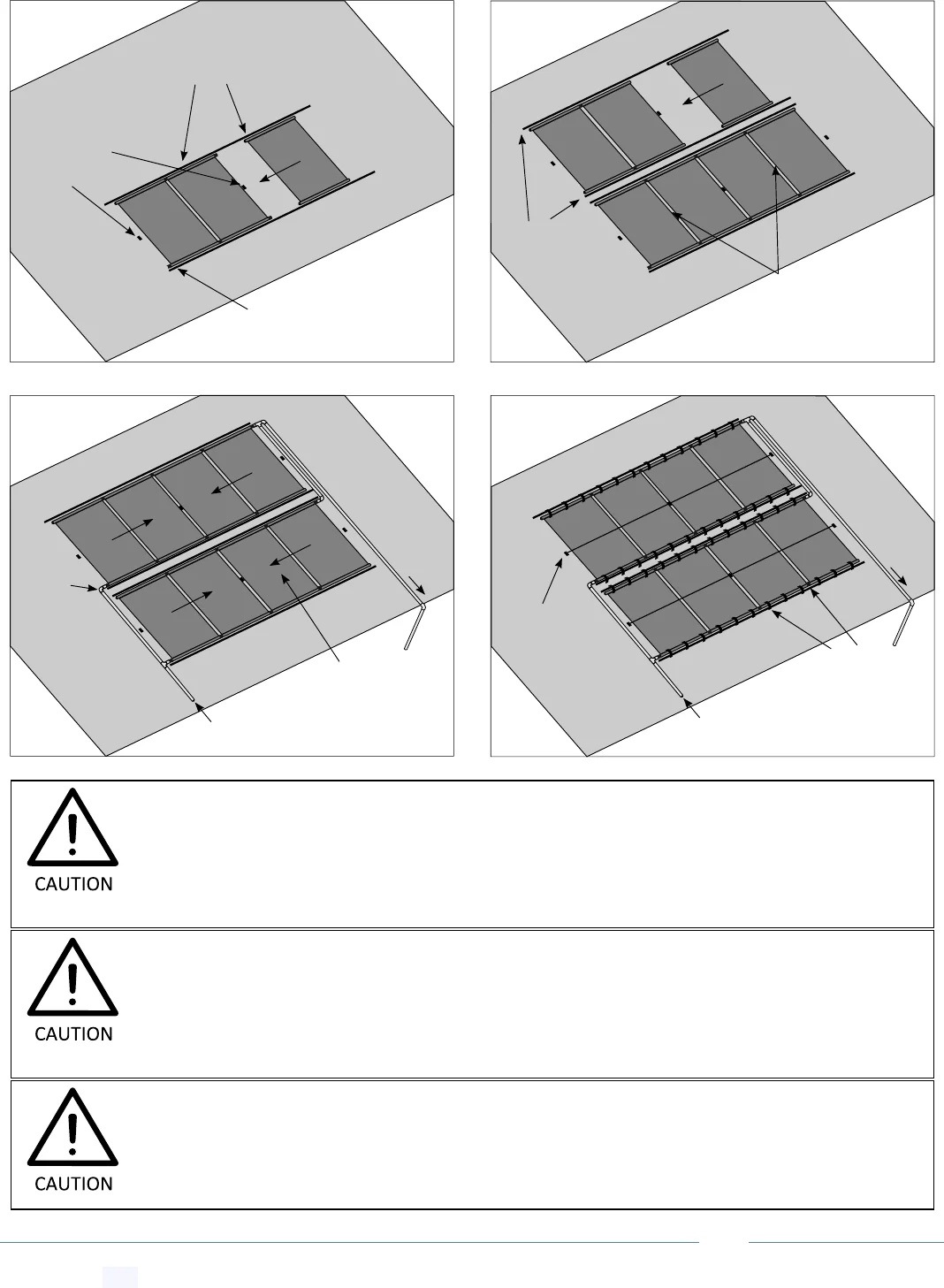
EcoOnline Performance+™ Solar Pool Heating System -- Installation & User Manual
© Copyright 2021 Optex Solar Pty Ltd. All rights strictly reserved.
Page 43
23.2 Mounting Procedure for Arrays 15 or Less Panels per Row
Create jump link to this section-- Get Link
You MUST “Season” the panels by placing them in the hot sun for half a day on one side and half a day on the other
side to minimize any age contraction issues later. Then follow this mounting procedure:
1 - Mount aluminium rails
top and bottom of each row
4 - Mount
second top
rail set
6 - Lay
plumbing
and turn on
water flow to
cool and
contract
panels
7 - With low pressure
water flowing
compress rows as
much as possible
9 - Install
any extra
windproofing
(if required)
8 - With cool
water flowing
strap panels and
tighten hose clamps
3 - Connect panels
and apply hose clamps,
but do not strap them yet
5 - Continue
to lay second
row (if
required)
2 - Install wind
proofing anchor
points
(if required)
No saddle
PVC pipe
fixings
near
plumbing
joins
Do not use fixed
anchors on last few
end array panels due to
thermal movement
Compact panels pipe to pipe, tighten clamps and apply fixing straps to cool panels only
(and/or with cool water running at low pressures, see Pressure Optimization section below),
and never hot panels. Why? Applying straps/clamps to hot panels can cause issues for large
arrays when the collector array contracts significantly in the cool of the night and over time.
For arrays containing 11-15 panels in a single row we strongly recommend aluminium
channels top and bottom for each row. Why? Panels strapped top and bottom to an
aluminium railing will have smaller side to side thermal movements.
For these arrays we recommend you locate the vacuum release off the roof and run the
system at a slight negative pressure. Why? A slight negative pressure will help reduce side to
side thermal movement, help compact panels during installation and guard against pool drain
events caused by a joiner pulling out.

EcoOnline Performance+™ Solar Pool Heating System -- Installation & User Manual
© Copyright 2021 Optex Solar Pty Ltd. All rights strictly reserved.
Page 44
23.3 Mounting Arrays with 15 or More Panels per Row
Create jump link to this section-- Get Link
Please contact info@EcoOnline.com.au for special expansion joiners if you need to run your array with > (greater
than) 15 panels per row.
Arrays containing more than 16-20 panels in a row should only be installed with special
expansion couplings in the middle of the row to account for the thermal movement. Arrays
greater than 20 panels are allowed with extra expansion couplers; however a 100L/min flow
rate limitation per row applies.

EcoOnline Performance+™ Solar Pool Heating System -- Installation & User Manual
© Copyright 2021 Optex Solar Pty Ltd. All rights strictly reserved.
Page 45
24 Plumbing Diagram Configurations
Create jump link to this section-- Get Link
24.1 Configuration 1: Independent/Separate System
Create jump link to this section-- Get Link
Notes: Solar pump can run independently of the filter pump. A and B are the recommended temperature sensor
installation zones for the controller
Advantages:
Disadvantages:
* More energy efficient as a small solar pump runs
independent of the large main filter pump
* Requires separate solar suction provisions to be
installed
When installing PVC lines, attention should be given to the minimum spacing for pipe
supports and thermal expansion of long length of pipe work and the stress this produces
on joins. For complicated installations we recommend a professional installer install the
system, unless you are confident of the work to be performed.
This system requires separate/independent Australian Standard approved suction and
return lines going into your pool. If you need to retro fit these you must contact a pool
builder.

EcoOnline Performance+™ Solar Pool Heating System -- Installation & User Manual
© Copyright 2021 Optex Solar Pty Ltd. All rights strictly reserved.
Page 46
24.2 Configuration 2: Integrated Independent System
Create jump link to this section-- Get Link
Notes: For pool with only 1 return port, the filter pump must be set on a timer to run outside of solar hours to
exclude the possibility of the two pumps running together. A and B are the recommended temperature sensor
installation zones for the controller
Advantages:
Disadvantages:
* More energy efficient as a small solar pump runs
independent of the large main filter pump
* Can be retrofitted to older pools depending on access
to underground suction line
* Pumps can’t run simultaneously for pools with only 1
return port.
* Suction tees above or only just below the water line
will require regular maintenance of non-return valves
24.3 Notes on Teeing into the Suction Line for Configuration 2
Create jump link to this section-- Get Link
If the pool has more than one return port and the filter pump and solar pump run together,
the installer must check the combined flow does not exceed suction inlet flow rate limits.
checked.
Note: the tee into the suction line must be performed far below the waterline (> 1m).
Why? When the filter pump starts it will create negative pressure in the suction line which
will drop the water line in the solar suction line - if the water line drops below the tee point
air will be drawn de-priming the main filter pump.
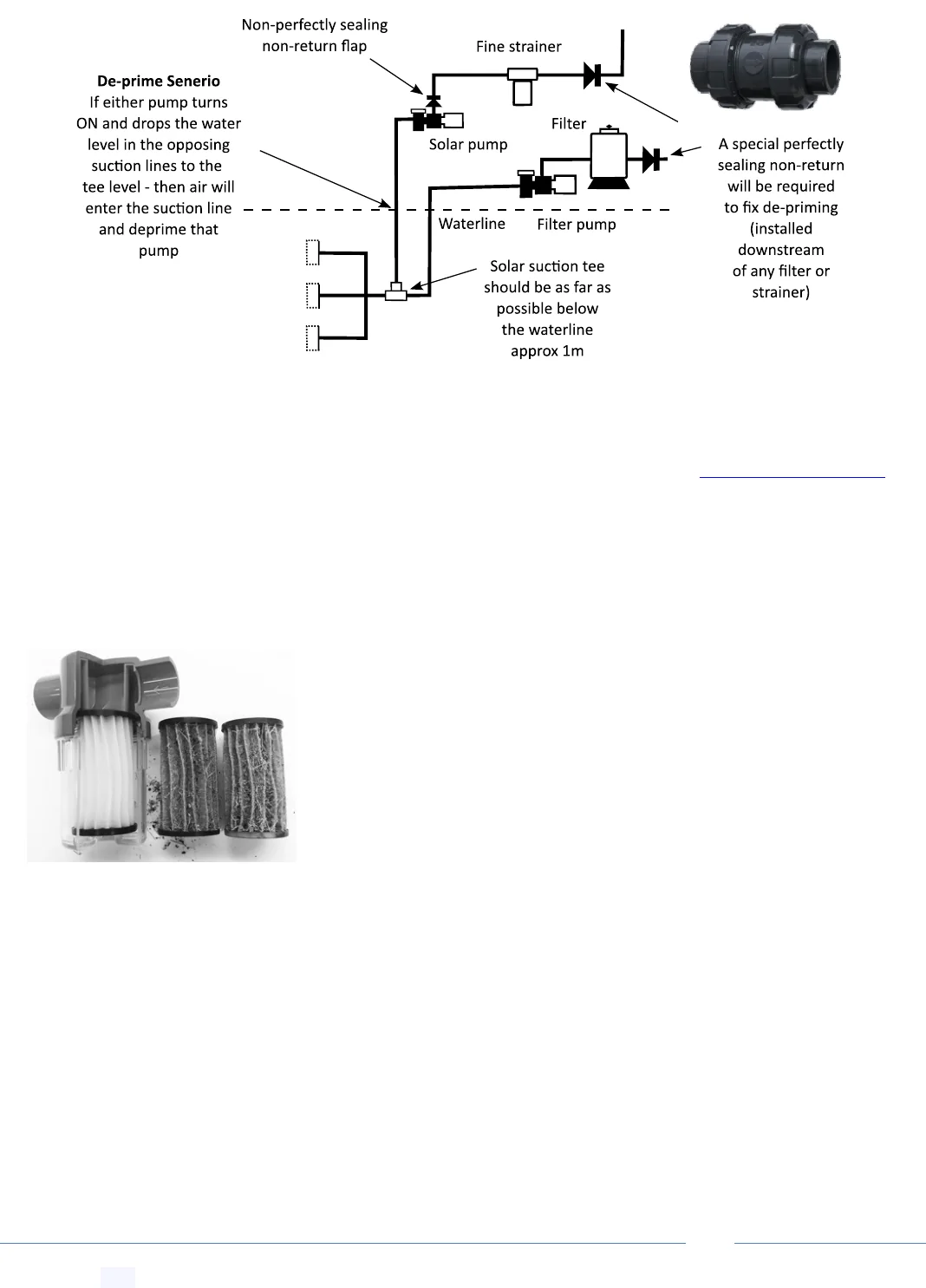
EcoOnline Performance+™ Solar Pool Heating System -- Installation & User Manual
© Copyright 2021 Optex Solar Pty Ltd. All rights strictly reserved.
Page 47
If the tee can’t be installed more than 1m below the waterline, or if it can only be installed above the waterline,
some installers will put in a perfectly sealing non-return on the solar line to stop the main filter pump de-priming.
Please be aware, this is a special valve with a polished ball and rubber seat, contact us at info@ecoonline.com.au if
you require it. A standard flap non-return will not suffice. Also note, such a system will need regular careful
maintenance of the solar and filter line non-returns. Any failures or even the smallest leaks in these non-returns, due
to twigs or grit getting into the rubber seal, will pass air and eventually de-prime pumps.
24.4 Installing the Tuffman Fine Strainer
Create jump link to this section-- Get Link
The above scenario you will require the Tuffman fine to protect the non-
return from fine grit and twigs. Depending on the level of pool use and debris
in the pool the strainer may need to be cleaned regularly. Use a jet of water.
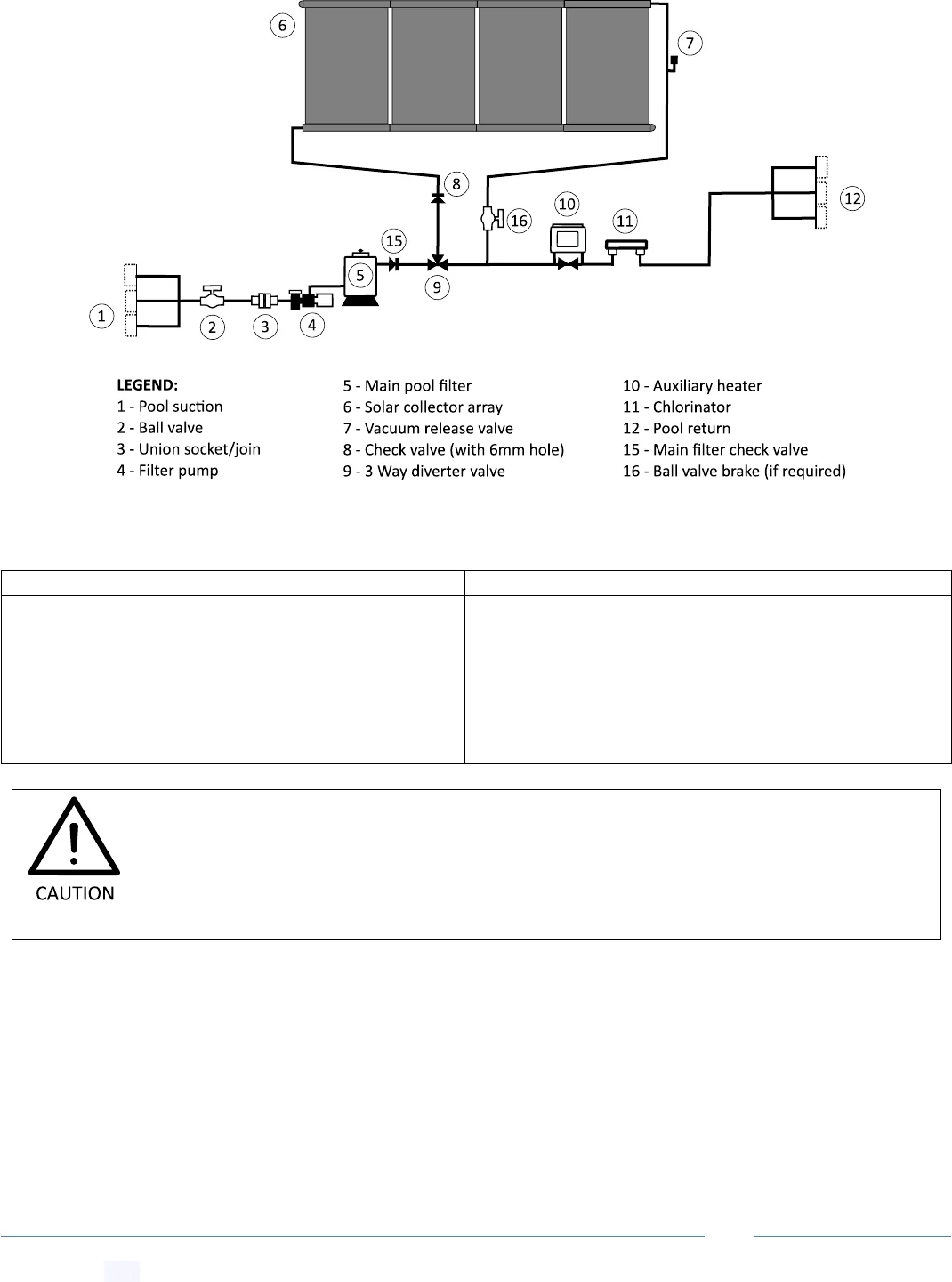
EcoOnline Performance+™ Solar Pool Heating System -- Installation & User Manual
© Copyright 2021 Optex Solar Pty Ltd. All rights strictly reserved.
Page 48
24.5 Configuration 3: Manual/Timer/Motorized Valve System
Create jump link to this section-- Get Link
Notes: Manual or motorized three-way valve (9). (Note: automatic controls are omitted for clarity).
Advantages:
Disadvantages:
* Manual system requires no extra pump required
* Manual system, needs to be turned off/on or on a timer
* Only filtered water runs through collectors
* Large main filter pump needs to run all day for solar
* Can be retrofitted to pools that don’t have separate
solar provisions
* Motorized three-way valve and controller can be
retrofitted later
* Requires specialized motorized valve and controller to
automate
* Increases pressure and decreases flow rate in the filter
system
* Not recommended for two story installations
For manual pool heating systems running off a main pool filter pump, please check that the
pump is large enough to accommodate the extra load of supplying water to the collectors
at the required pump height. Generally, this configuration is not recommended for two
story or greater installs.
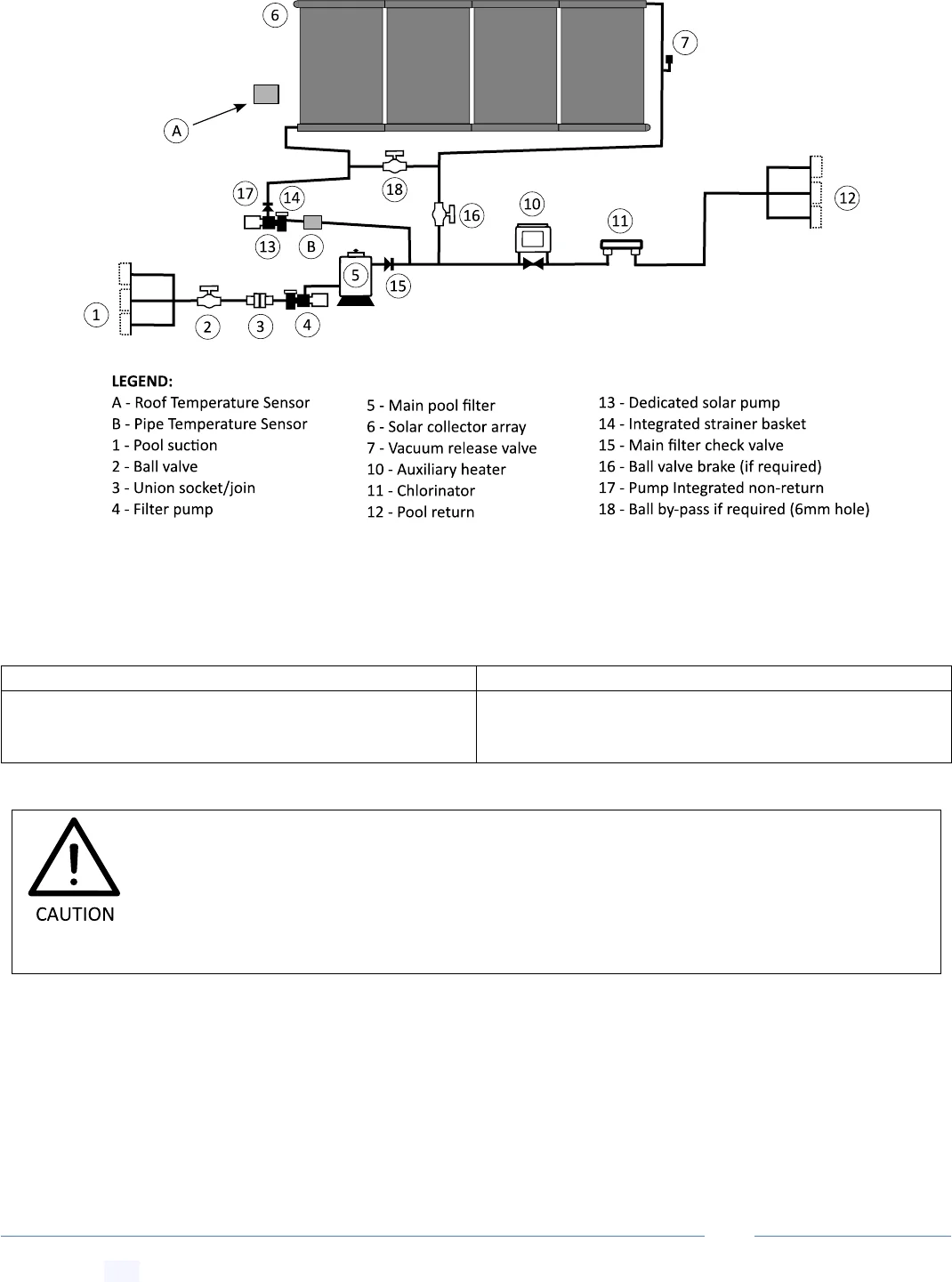
EcoOnline Performance+™ Solar Pool Heating System -- Installation & User Manual
© Copyright 2021 Optex Solar Pty Ltd. All rights strictly reserved.
Page 49
24.6 Configuration 4: Booster/Retrofit System
Create jump link to this section-- Get Link
Notes: Solar booster pump locked to run with filter pump - requires specific controller Dontek V7RTS. Solar pump
(13) should of lower flow than filter pump (4). A and B are the recommended temperature sensor installation zones
for the controller
Advantages:
Disadvantages:
* Less extra plumbing is required for solar
* Requires second pump and special controller
* Only filtered water runs through collectors
* Does not require separate solar suction provisions
* Large main filter pump + solar pump need to run all
day for solar
This configuration is not recommended for single story installs for pools with only a single
return port due to the potential over pressurization of the panels when both pumps run at
the same time. However for two story or greater installs, even with a single return port, this
is the recommended configuration for pools that don’t have separate suction ports.
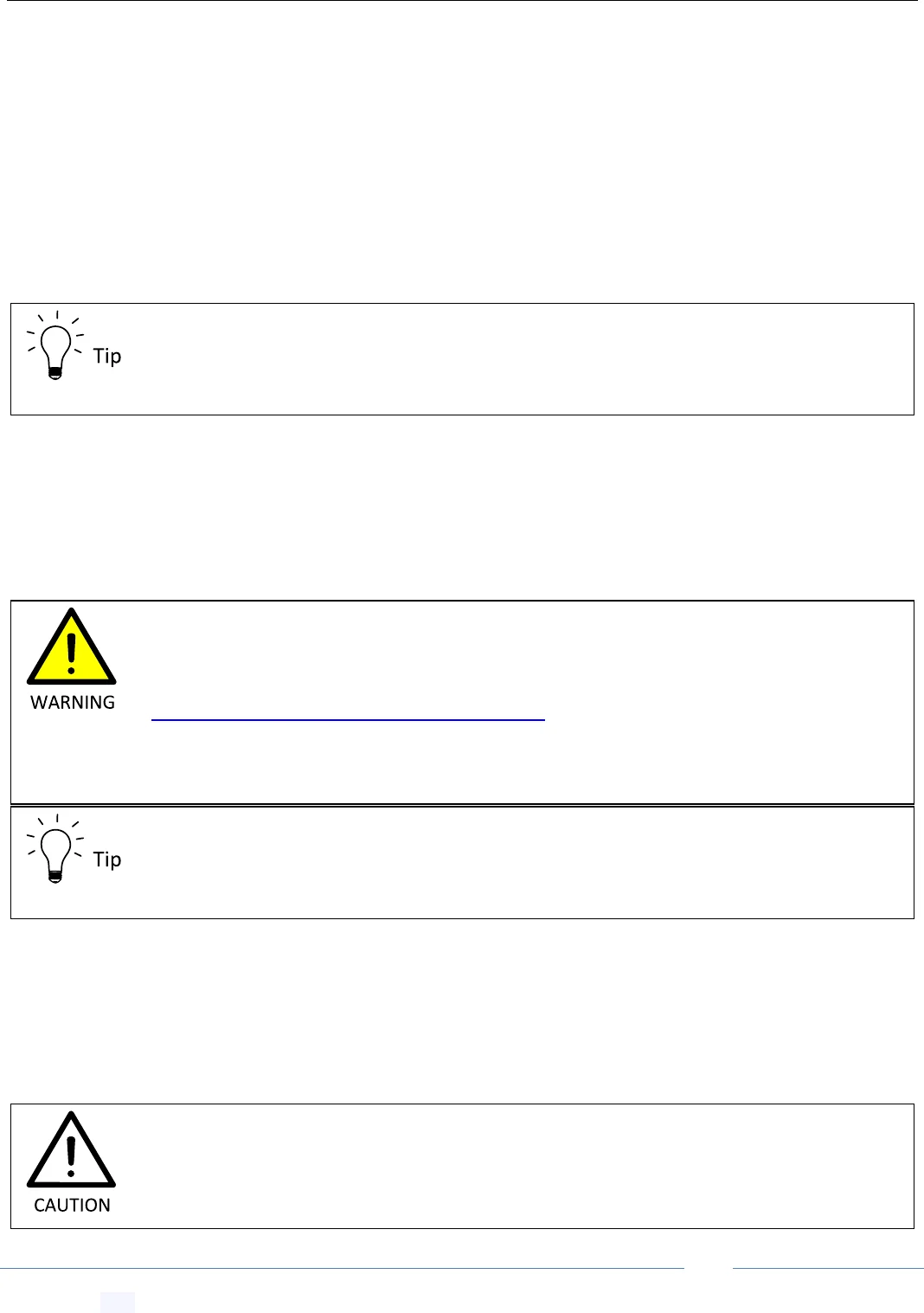
EcoOnline Performance+™ Solar Pool Heating System -- Installation & User Manual
© Copyright 2021 Optex Solar Pty Ltd. All rights strictly reserved.
Page 50
25 Installing the Controller for Independent Systems
Create jump link to this section-- Get Link
Please refer to the controller manual as different controllers have specific installation instructions. Here we only add
supplemental instructions; they should not override any specific controller instructions. Note: controller manuals are
downloadable from the EcoOnline website.
25.1 Installing the Roof/Hot Sensor
Create jump link to this section-- Get Link
If your controller comes with a long 20m cord hot roof sensor it should be adhered using silicon to a sun exposed
roof tile or section of corrugated metal roof. It should NOT be installed, on top off, inserted into, or under an OKU
panel. Ideal placement is within arm’s length of the gutter.
25.2 Installing the Pool/Cold Sensor
Create jump link to this section-- Get Link
The cold sensor should be fitted inside a section of PVC suction line (before the solar pump) and sealed using the
grommet supplied. For this you will need to drill a hole in the suction line, please check the controller manual for the
recommended size.
25.3 Extending Sensor Cords
Create jump link to this section-- Get Link
The sensor cords can be extended using a similar type cord but in a larger gauge wire. Note, the Dontek cold sensor
uses a shielded type cord; hence you will need the same (but in a higher gauge) if extending it. Please contact
Dontek or Ascon if unsure.
When extending the cord we recommend a “lap splice” solder join with adhesive heat shrink.
Solder joins should not placed in any conduit section running under ground.
If the cord is too short the sensor can also be located on any unshaded “roof proxy”
surface that faces the same part of the sky as the panels to approximate the surface
temperature of the roof itself. Alternatively, it can be extended see below.
Standard unmodified drill bits have “positive rakes” and can easily “bite into” soft
materials. This can cause a sprain injury as a hand drill will violently kick and spin. Drill bits
can easily be modified to “zero rake” to prevents this, see
https://www.youtube.com/watch?v=pAngKHIZgyA. Alternately, a step drill bit or a
standard drill bit spun backwards can be used. A cone shaped rolled up piece of sandpaper
can be used to even out or increase the diameter of the hole to size.
PVC plastic should be preheated to 50˚C using a heat gun to prevent it from splitting
during drilling. We recommend you practice on a pipe off cut before attempting the
hole.
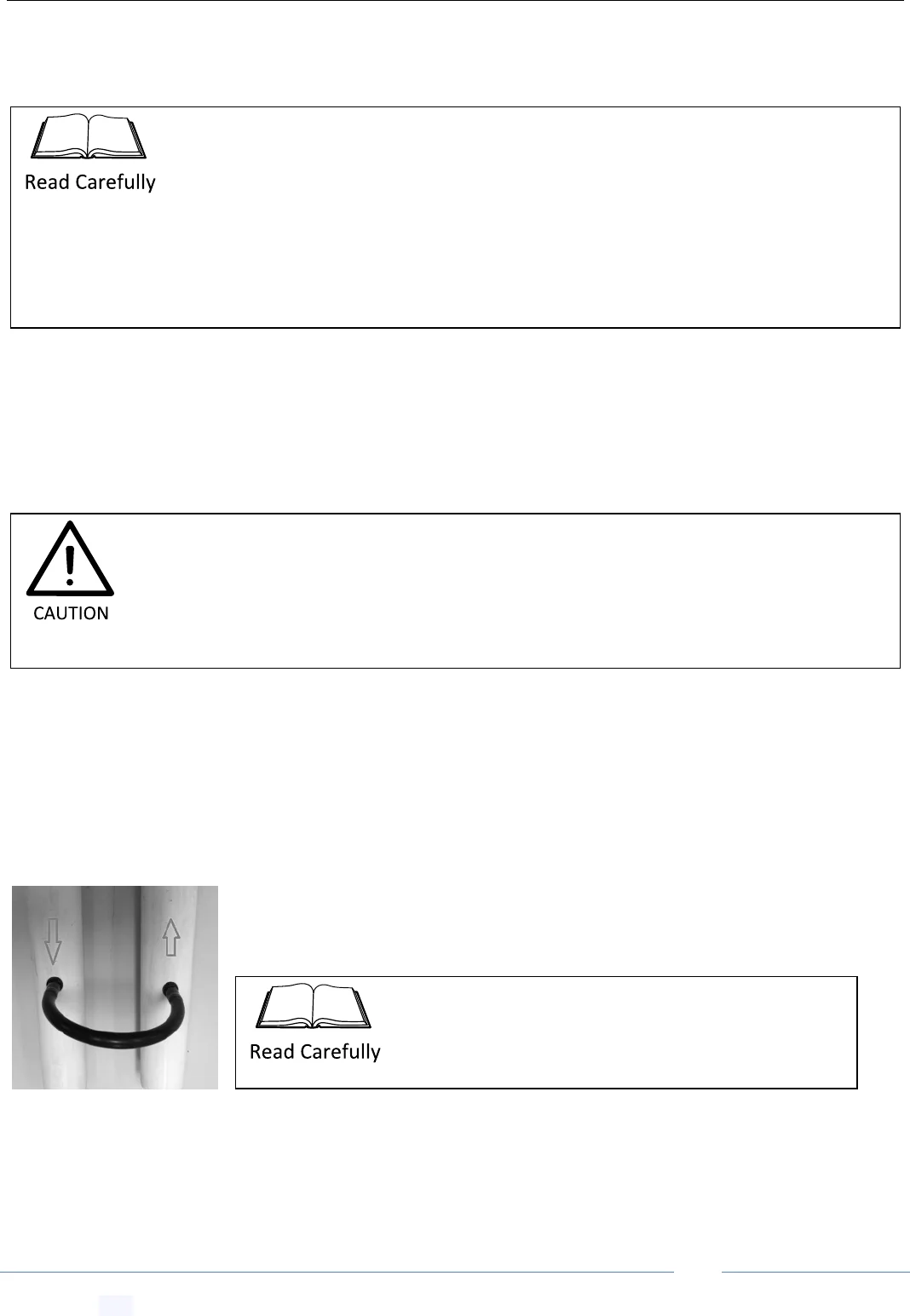
EcoOnline Performance+™ Solar Pool Heating System -- Installation & User Manual
© Copyright 2021 Optex Solar Pty Ltd. All rights strictly reserved.
Page 51
26 Drain-Down, Frost Proofing and Winterization
Create jump link to this section-- Get Link
26.1 Drain Down
Create jump link to this section-- Get Link
All pool heating systems have a drain down design and MUST drain as fully as possible when the system stops.
26.2 Winterization
Create jump link to this section-- Get Link
Please note, while your potable HPDE/Silicon collector array does not require regular winter flushing, your solar
booster pump may require winter flushing. If this is the case and you do not want to run your system over winter
you can winterize your system by draining the solar side of the system, disconnecting the solar booster pump and
flushing the pump with clean water for storage over winter.
26.3 Installing a By-Pass Tube or By-Pass Ball Valve (18)
Create jump link to this section-- Get Link
A drain tube (or a by-pass ball valve with 6mm hole) can be used to drain non-self draining sections of PVC piping in
frost prone areas. In some cases where there are issues with pump priming and a perfectly sealing non-return valve
(8) is required; the aforementioned by-pass lines can be installed on the supply and return solar lines leading up to
the roof approximately one metre above pump level to reduce priming pressure. Please request this component if
you require it.
To install, drill into the PVC pipe using a modified “zero rake” 8.5mm drill bit. Insert the
rubber grommet into the hole first, and then insert the single barb side barb into the
grommet. Finally connect the by-pass tube to the double barb side barb ends.
The use of a water tight non-return valve on the solar supply will prevent drain down
which could result in water freezing inside PVC piping in frost prone areas and/or hot
water stagnation in summer. Any non-return valves installed on the supply line MUST
have a 6mm drain hole drilled in the flap to allow drain down. Why? The main purpose
of the non-return valve is to prevent a large volume of water from spinning the pumps
rotor backwards when the pump stops. A 6mm hole allows slow drain down while also
preventing hammer action in the flap when the pump stops.
PVC piping should be installed with a slope such that all water drains out of the piping to
when the pump stops to ensure a freeze proof system. There should be no U-bend water
traps - these can freeze over and burst plumbing lines in the winter. Note: PE lines are not
affected as these are frost impervious.
Independent systems with a drain tube anywhere in the
system MUST be installed with a fine (<0.5mm) strainer,
or else this tube may get blocked up.
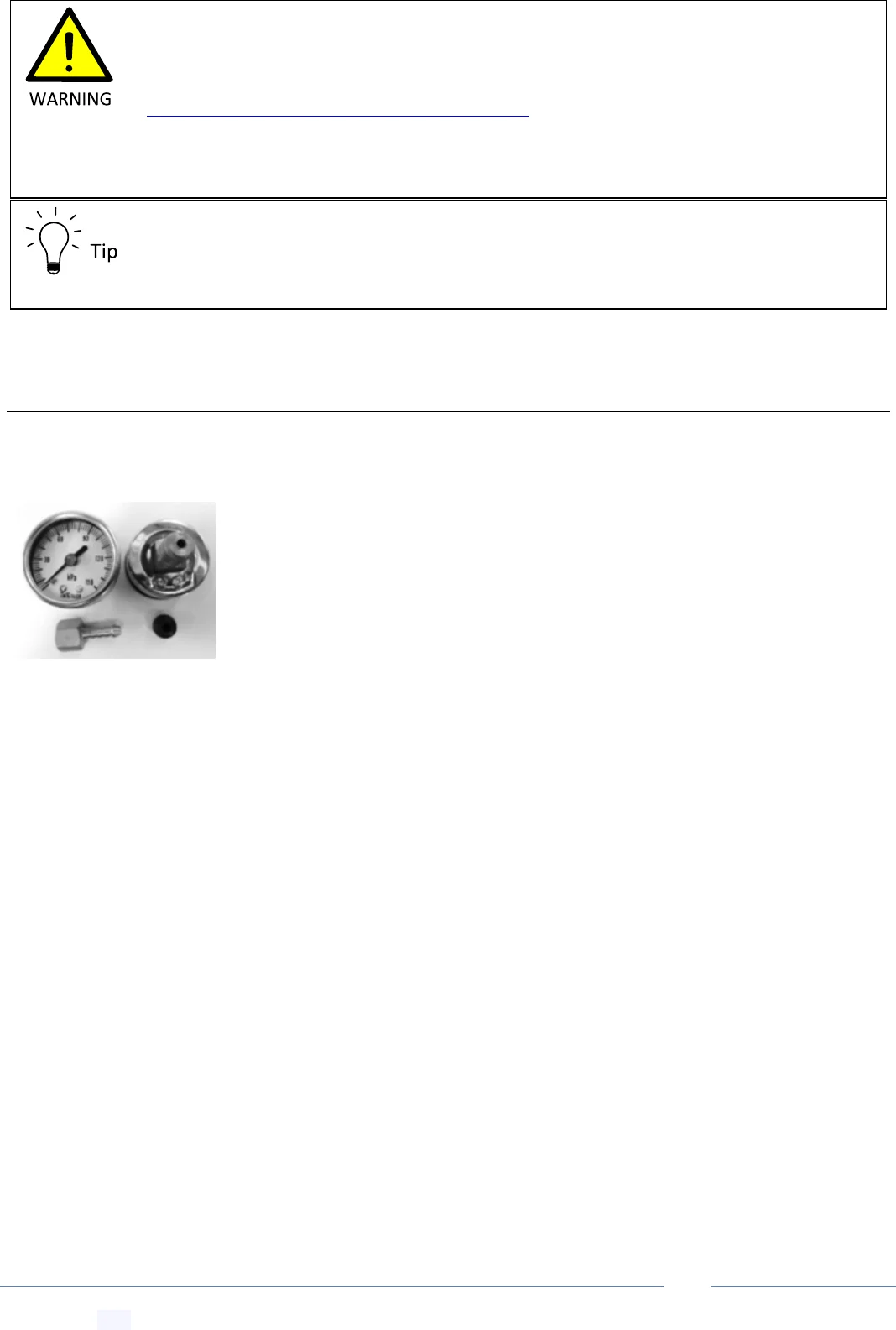
EcoOnline Performance+™ Solar Pool Heating System -- Installation & User Manual
© Copyright 2021 Optex Solar Pty Ltd. All rights strictly reserved.
Page 52
27 Optimizing Collector Pressure
Create jump link to this section-- Get Link
27.1 Installing the Pressure Gauge
Create jump link to this section-- Get Link
The pressure gauge must be installed on the return line preferably near eye level. Drill
into the PVC pipe using an 8.5mm drill. Insert the rubber grommet into the hole
tapered end first. Use pink Teflon tape on brass tread, lubricate the brass barb with
silicon spray prior to insertion into the grommet. Note: PVC plastic should be
preheated to 50˚C using a heat gun or it may split when drilling.
27.2 Zero Pressure Panel Check Procedure
Create jump link to this section-- Get Link
To make pressure adjustment depending on over-pressure or under-pressure situations, you’ll need to install either
a ball by-pass valve (18) to reduce pressure or a ball break valve (16) on the return line to increase back pressure
(both at near ground level for easy adjustment). Manual type systems need only the adjustable 3-way ball valve.
Collector pressures can then be adjusted as follow:
Standard unmodified drill bits have “positive rakes” and can easily “bite into” soft
materials. This can cause a sprain injury as a hand drill will violently kick and spin. Drill bits
can easily be modified to “zero rake” to prevents this, see
https://www.youtube.com/watch?v=pAngKHIZgyA. Alternately, a step drill bit or a
standard drill bit spun backwards can be used. A cone shaped rolled up piece of sandpaper
can be used to even out or increase the diameter of the hole to size.
PVC plastic should be preheated to 50˚C using a heat gun to prevent it from splitting
during drilling. We recommend you practice on a pipe off cut before attempting the
hole.

EcoOnline Performance+™ Solar Pool Heating System -- Installation & User Manual
© Copyright 2021 Optex Solar Pty Ltd. All rights strictly reserved.
Page 53
Gauge Pressure
Pressure Adjustment Advice
Less than:
Head Pressure - 2 kPa
Install ball valve brake (16) (see plumbing diagrams) to
increase back pressure in return line
Up to:
Head Pressure + 4 kPa
Pressure is okay no action required
Greater than:
head Pressure + 4 kPa
Excessive pressure - install extra pool returns or remove
eyeballs from returns, or install by-pass (19) with ball valve
Head Pressure :
Vertical measure
from vacuum
release to
pressure gauge
Note:
1m vertical Head Pressure = 10 kPa
2m vertical Head Pressure = 20 kPa
To
pool
Pressure gauge is mounted
above the break ball valve
0 kPa
23 kPa
head
pressure
2.3m
example
pressure
gauge
reading
For an example 2.3m vertical
distance between the vacuum
release and the pressure
gauge, the gauge
should read:
~ 23 kPa
Ideal pressure gauge reading
=
Head Pressure
It’s important OKU panels are run at near zero pressure up on the roof, however pressure ±
4kPa are also acceptable. Larger pressure may limit collector lifetimes.
Why? Plastic longevity is strongly dependent on pressure fluctuations and temperatures.

EcoOnline Performance+™ Solar Pool Heating System -- Installation & User Manual
© Copyright 2021 Optex Solar Pty Ltd. All rights strictly reserved.
Page 54
27.3 Negative Pressure and Air Bubble Issues
Create jump link to this section-- Get Link
If the pump height is substantial and/or you have more than one return outlet to your pool, it may be that your
pump cannot positive pressurize the vacuum release valve. In this case you will get undesirable constant bubbling in
the outlet to the pool as the vacuum release valve is at negative pressure and is drawing in air. If this happens you
will need to install the down draft/brake PVC ball valve (16) on the return line (see plumbing diagrams) and carry out
the following procedure:
Start the system and wait for it to settle.
1) Constrict flow in the return line using the ball valve brake (16, see plumbing diagrams) lever handle by a
small increment.
2) If after some time the air bubbling continues, constrict flow by another small increment.
3) If air bubbles stop reliably at this point then the vacuum valve is now at the required positive pressure, the
pressure gauge should read a value near the head pressure (vertical distance from vacuum release and
pressure gauge) + a few kPa’s, this is ideal.
4) Leave the ball valve brake at this setting/constriction permanently (remove handle).
5) If the required constriction is greater than 50% you will need a stronger pump.
27.4 Adjusting the 3 Way Valve for Manual Systems
Create jump link to this section-- Get Link
The following procedure for a manual system need be carried out only once during installation.
1) Open the three way ball valve (9, see plumbing diagrams) using the lever handle by a small increment.
2) Wait to see if there is sufficient flow and back pressure to create positive pressure at the vacuum valve (7).
3) If after some time air bubbling is still present in the return line, open the three way valve (9 see plumbing
diagrams) by another small increment.
4) If air bubbles stop reliably at this point then the vacuum valve is now at the required positive pressure.
5) Fix in place a back stop on the ball valve lever handle at this travel point, as this will be your maximum
opening point for your three way valve when turning the heating system on again.
Never expose the collector array to temporary pressures greater than 16 psi (110kPa).
Note: if for whatever reason water flow is fully blocked, a pump with a 15 meter head
pressure will generate 150kPa at ground level, 100kPa at 5m and 50kPa at 10m.
Use the below procedure for solving air bubbling issues, DO NOT remove or drop the
level of the vacuum release valve or increase pump strength. The vacuum release valve
MUST be mounted as specified to ensure collectors are not pressure worked.
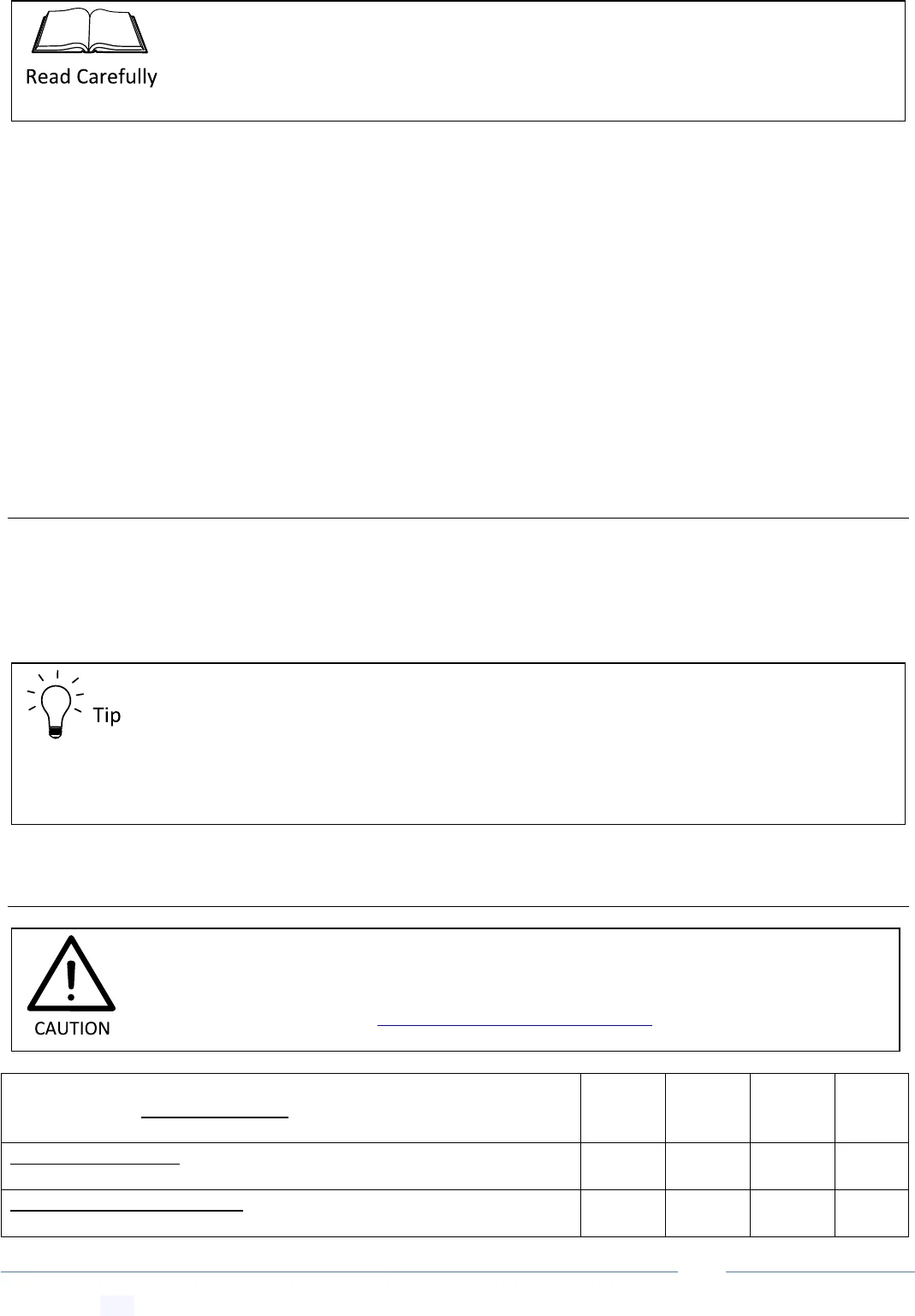
EcoOnline Performance+™ Solar Pool Heating System -- Installation & User Manual
© Copyright 2021 Optex Solar Pty Ltd. All rights strictly reserved.
Page 55
27.5 Optimizing Pressure for Oversized Pumps
Create jump link to this section-- Get Link
For an over-sized solar pump (13, see plumbing diagrams) we recommend the following procedure, carried out only
once during installation, to limit pressures inside the panels.
1) Removed any potential constrictions in the return line going back into the pool such as eyeballs in the return
outlets.
2) If pressure is still too great (as measured at the pressure gauge, see above Pressure Check Procedure, install
a by-pass ball valve (18) (see plumbing diagrams).
3) Turn the solar pump on with the by-pass-ball valve fully open.
4) Constrict the by-ball valve in small increments until you get the correct pressure, see above.
5) Fix the by-pass ball valve handle in place by some means.
28 Checking for Balanced Water Flow
Create jump link to this section-- Get Link
At midday with the sun shining on the collectors and the pump running, run your hand over every part of each
collector in the array. The bottom face of each collector should be cool to the touch while the top of each collector
maybe slightly warmer to the touch. No part of any collector should be hot to the touch. Hot spots indicate that
there is no water flow through this part of the collector.
29 Service and Maintenance Schedule
Create jump link to this section-- Get Link
Maintenance Issue - Service Procedure
1
st
Month
1
st
Quarter
Annual
Checks
After
5
Years
Plastic Barbs Relaxing - All the stainless steel hose clamps may need
retightening as plastic relaxes overtime (hand tighten only).
X
X
Silicon Joiner Chemical Attack – Disconnect a single silicon joiner, dry
and check that the water exposed inside section has not turned grey or
X
X
During operation the outlet water flow should be strong with a temperature no greater
than about 1-2°C that of the inlet. Why? Faster flows rates will result in lower
temperature differences across the collector array and higher collector efficiencies;
however this should be balanced against electricity usage and maximum allowable panel
pressure.
Important: before carrying out any system maintenance you MUST check for any manual
and or technical service bulletin updates and download the latest installation manual
from our Downloads Page: www.EcoOnline.com.au/downloads
Over-sized pumps and flow rates could potentially limit the lifetime of your collectors
due to pressure working. Note, the return line to the pool MUST be unconstricted, with
an appropriate number of pool outlets so as not to create significant back pressure.
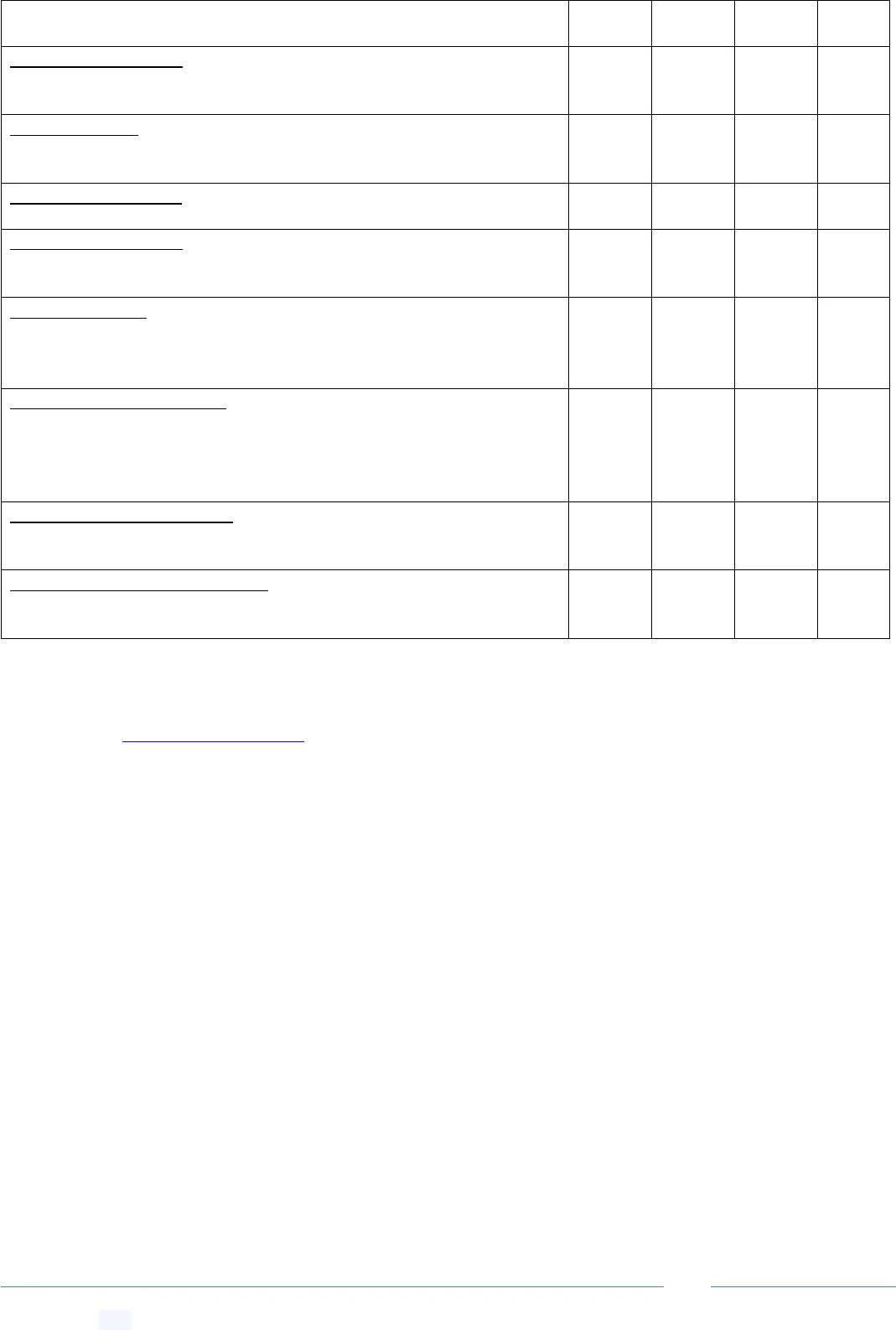
EcoOnline Performance+™ Solar Pool Heating System -- Installation & User Manual
© Copyright 2021 Optex Solar Pty Ltd. All rights strictly reserved.
Page 56
become unfirm to the touch. This would indicate chemical attack from a
pH lower than 7. Replace as needed.
Stainless Strap Fatigue - Inspect all stainless steel fixing straps for wear
of PVC coating around the sharp Aluminium L-angle edge, which would
indicate fatigue working of straps. Replace as needed.
X
Mounting Frame - The integrity of the collector mounting frame and
windproofing components should be checked for any degradation.
Replace as needed.
X
Plumbing Degradation – Plumbing lines and fittings should be checked
for signs of UV and/or chemical damage. Replace as needed.
X
Vacuum Release Valve – The vacuum release valve (7) is a critical system
component. It should be checked that it is not weeping corrosive water
onto the roof.
X
Non-Return Valve – The non-return valve (8 see plumbing diagrams) is a
critical system component. It should be checked that the 6mm hole
drilled in the flap has not become blocked and that the collectors drain
fully when the pump stops.
X
Collector Plastic Contraction – Collectors can relax and contract by
10mm in length over the initial first few years. It should be checked that
the stainless steel straps or fixings have not become too tight as a result.
If required, straps will need to be loosened slightly. This check should be
carried out when the collectors are cool (water flowing).
X
Debris Accumulation on Roof – Check that there is no build up of debris
around pipework or collectors, and that water has a clear path to run
down.
X
Debris Accumulation in Collectors – Inspect the inner of the collectors.
Depending on conditions collectors may need to be flushed with a
suitable cleaning agent for debris accumulation after many years of use.
X
29.1 Collector Repair Procedure
Create jump link to this section-- Get Link
Please contact info@EcoOnline.com.au
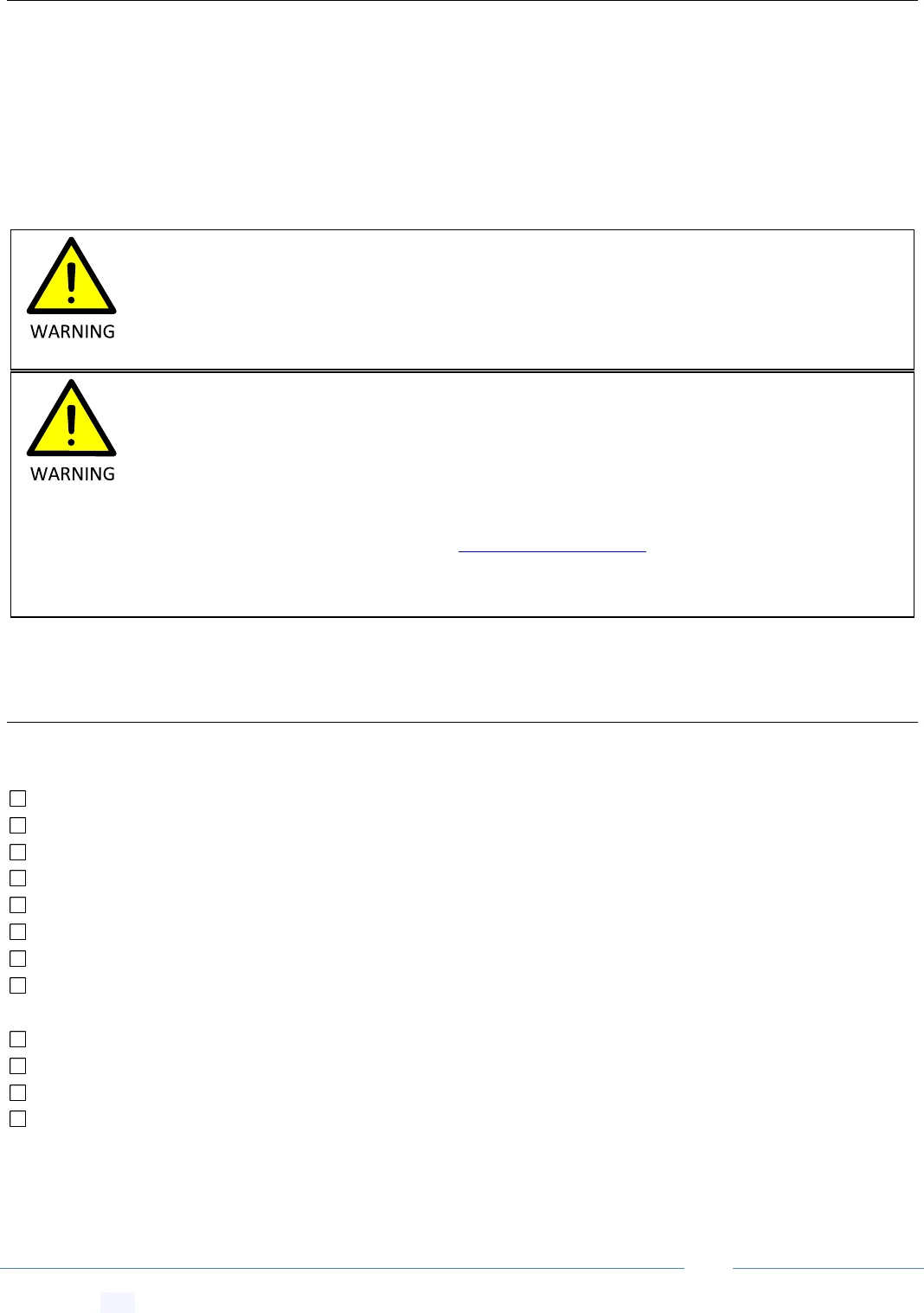
EcoOnline Performance+™ Solar Pool Heating System -- Installation & User Manual
© Copyright 2021 Optex Solar Pty Ltd. All rights strictly reserved.
Page 57
30 User Information
Create jump link to this section-- Get Link
30.1 Notes on First Usage
Create jump link to this section-- Get Link
After the system is switched ON for the first time, please be aware that it will take up to one week for the pool and
the surrounding ground around the pool to warm up and come to a new temperature equilibrium. As such systems
that are used intermittently, for example on weekends only, will not result in pool temperatures as high as
continuously ON systems.
30.2 Potential for Hot Water at the Outlet on Start Up
Create jump link to this section-- Get Link
31 Important Installation Check List
Create jump link to this section-- Get Link
Your installation must have the following elements.
Correctly sized pump or pressure optimization carried out.
The top header pipe for any row was installed with a very small slope toward the outlet or is at least level.
Aluminium channel was laid top and bottom of each row or for a maximum of two rows.
The stainless steel strapping was installed with sufficient play to allow for collector contraction.
Ultimate uplift wind loadings were considered and panels secured appropriately.
A hot spot check was performed. All collectors are cool during full sun exposure (top of panels may be warmer).
Smooth flow is achieved; little air bubbling is present in pool after initial purging.
Frost proofing was considered. All collectors and PVC lines are sloped and arranged such that water runs back
into the pool at night.
A vacuum release valve MUST be installed on the roof on the return line.
A non-return valve was installed (with a small 6mm hole drilled in the flap).
Solar controller roof sensor was mounted on the roof and not on a solar collector.
User is aware of the maintenance schedule.
Users should be made aware that under rare conditions on system start up, very hot water
~ 60°C will be ejected at the outlet return ports which has the potential to scold swimmers.
Users (especially children) should be advised to keep away from outlet during start up.
Due to the potential for hot water at the outlet on start-up, solar heating outlets must not
be connected to water features or waterfalls, or any other outlet(s) that are not
permanently fixed underwater. Where practicable, solar heating systems shall be designed
to completely drain down. Where a solar heating system cannot be designed to drain
down, a water bypass or tempering device arrangement shall be installed prior to the solar
heating outlets into the pool. Contact info@EcoOnline.com.au for a recommended return
line water tempering configuration.
